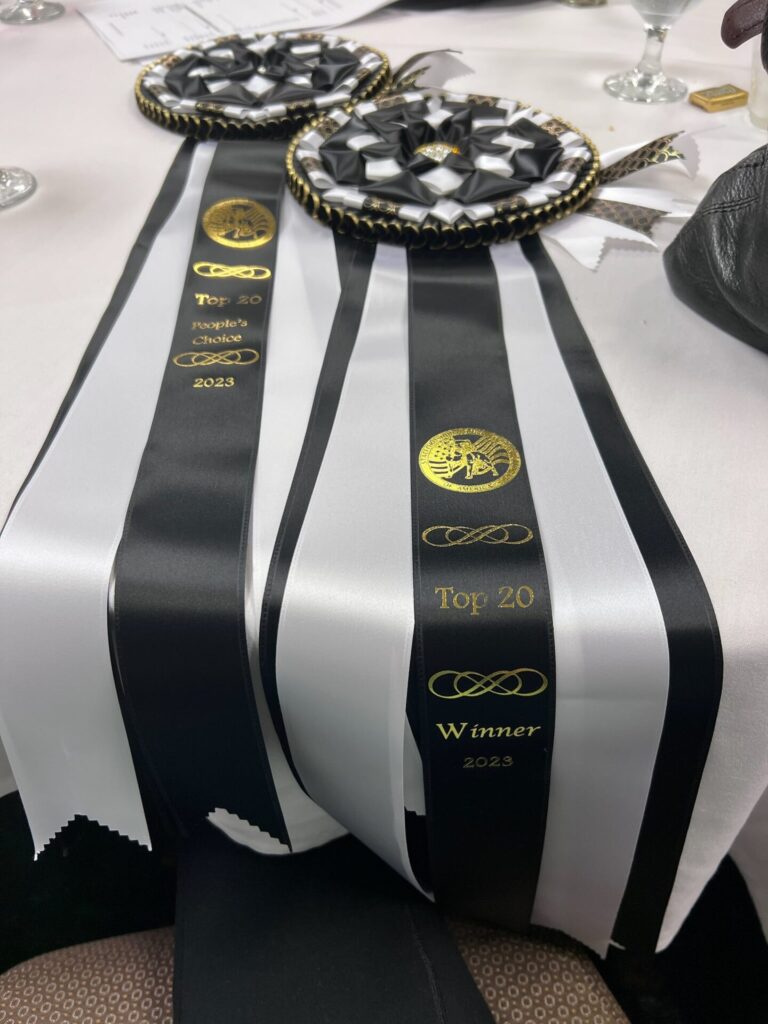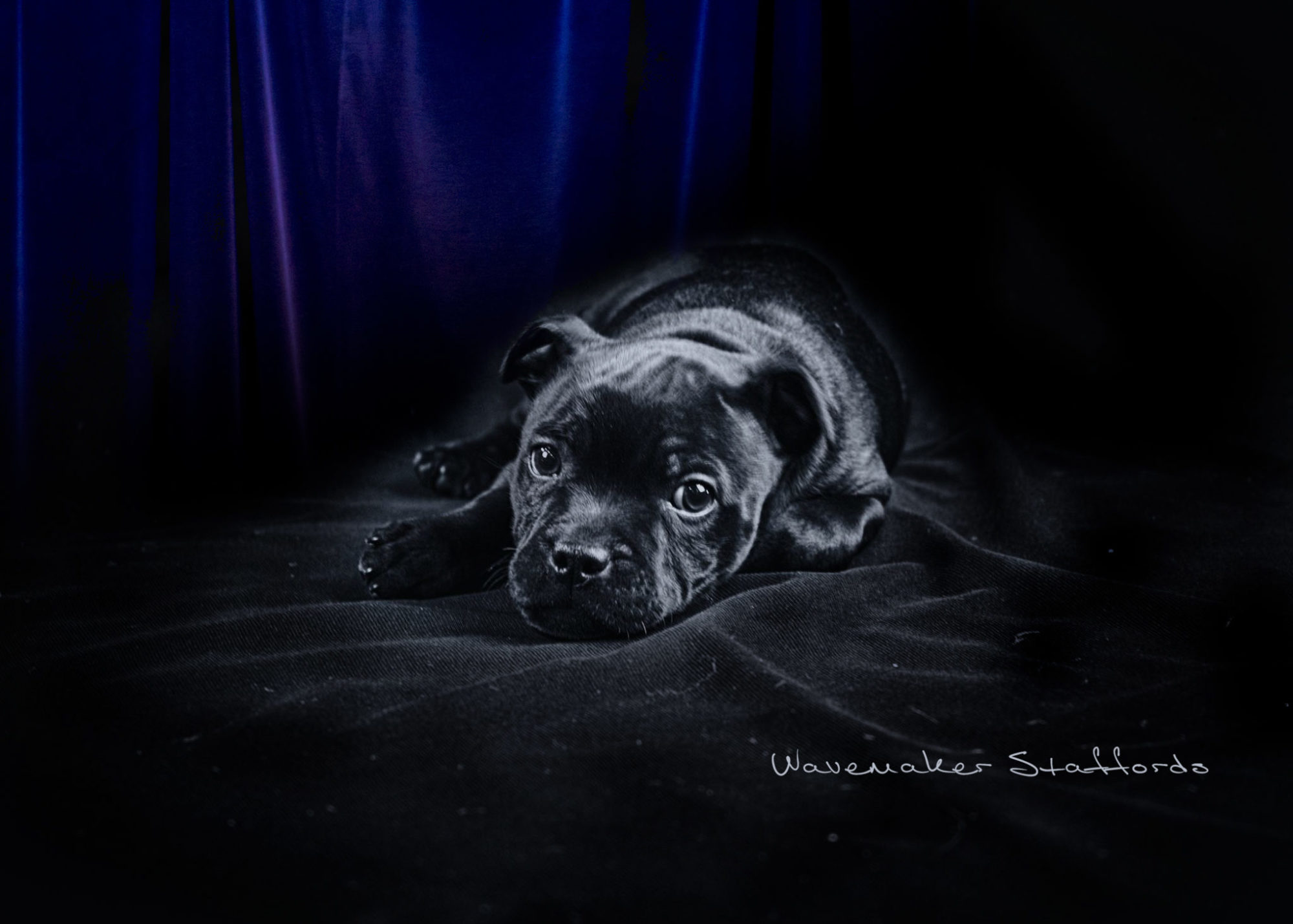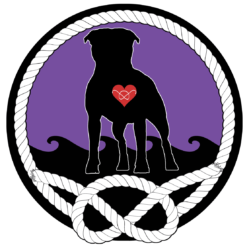A big big love . . . . . . .
That moment on a quiet Sunday afternoon your phone rings and for a split second you know whats about to happen and you wish you could roll back time. As a breeder my owners become family. When they experience proud moments and joy, so do I. When their hearts break, mine does as well. Today an amazing Stafford crossed that bridge and for now we cannot follow. Her beautiful spirit was needed elsewhere. Until we meet again sweet Sage. You are so very loved. x
Overseas Judging Adventures
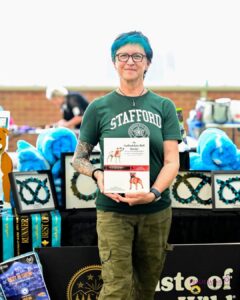
Recently we had the opportunity to travel to Australia and New Zealand where Lynn was invited to judge Staffords. What an honor and opportunity this was!
The first show, The Staffordshire Bull Terrier Club of Victoria was to be held on Saturday morning 9th March but the weather did not cooperate and their KC canceled the weekend shows. Thankfully the fast thinking and very hard working committee made arrangements for us to begin the shows on Friday evening at 5:30. They held an Open Show along with my Champ Show inside the building. The temps were in the 90’sº F and it was simply sweltering indoors and out but we had fans, the dogs and people had water and as they say. . . . the show must go on.
I had no time to rest or catch up on jet lag as I had to spring into action and get to it – and what an amazing sight was in front of us as we entered the building! The trophy table was so loaded down I thought at any moment it would collapse! They had so many sponsors that my mind was taking notes since I am on our SBTCA 50th Golden Anniversary Jubilee committee. The tables were spectacular (on my show Friday evening and for Gary’s show which was moved to Monday morning).
Thank you all for this wonderful opportunity. What an honor it was to be invited to travel to Australia to judge your Champ show. I also wish to sincerely thank the hard working and well-organized committee and to Penni for answering all of my questions while we were organizing the travel and making me laugh so much. Thank you to all of the exhibitors for accommodating for the last-minute changes to our schedules and having the show on Friday evening instead of Saturday morning as was the plan prior to the extreme heat instead of canceling. Thank you to my amazing Ring Steward Belinda T., and ticket writer Carol who both kept me hydrated and on my feet despite jetlag and the heat. Further thanks also is extended to Belinda F. and Josh for all the support and laughs. Much appreciation to all who entered for accepting my decisions with grace and making the experience a fun one. A special thank you to Erica and Paul for the fantastic adventures after the shows.
I was pleased at the quality, especially your bitches, and extremely happy to see so many issues we see in our breed elsewhere not a true issue at this event. I saw only a couple with pinched nares, most had beautifully open nostrils and long enough muzzles. Very few exhibits had wrinkle, loose skin or short muzzles. There were some mouth issues, specifically converging canines and a couple with level bite. Most were in good fit condition, with only a few who lived a tad too close to the snack bin. There needs to be a look at improving movement, specifically too close in the rear, which tends to be an issue worldwide currently. Pay attention to fronts as well as there seemed to be a bell curve from pinched fronts to too wide with overloaded shoulders book casing many with good square and balanced fronts. Overall tail carriage was excellent, very close to the Standard as well. Thank you again to all.
The Staffordshire Bull Terrier Club of Victoria
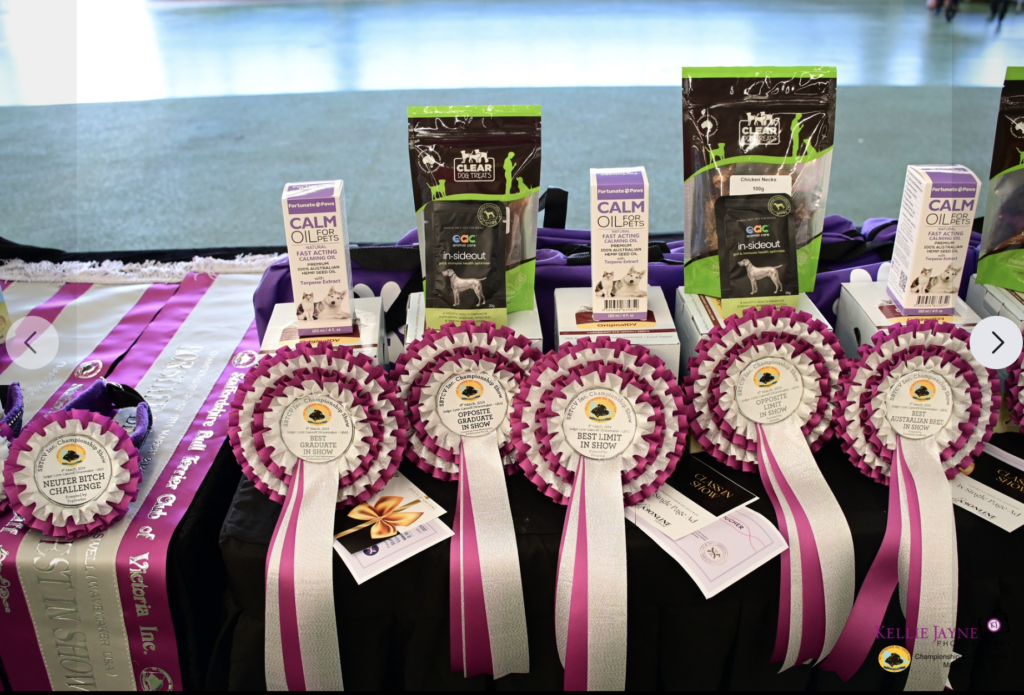
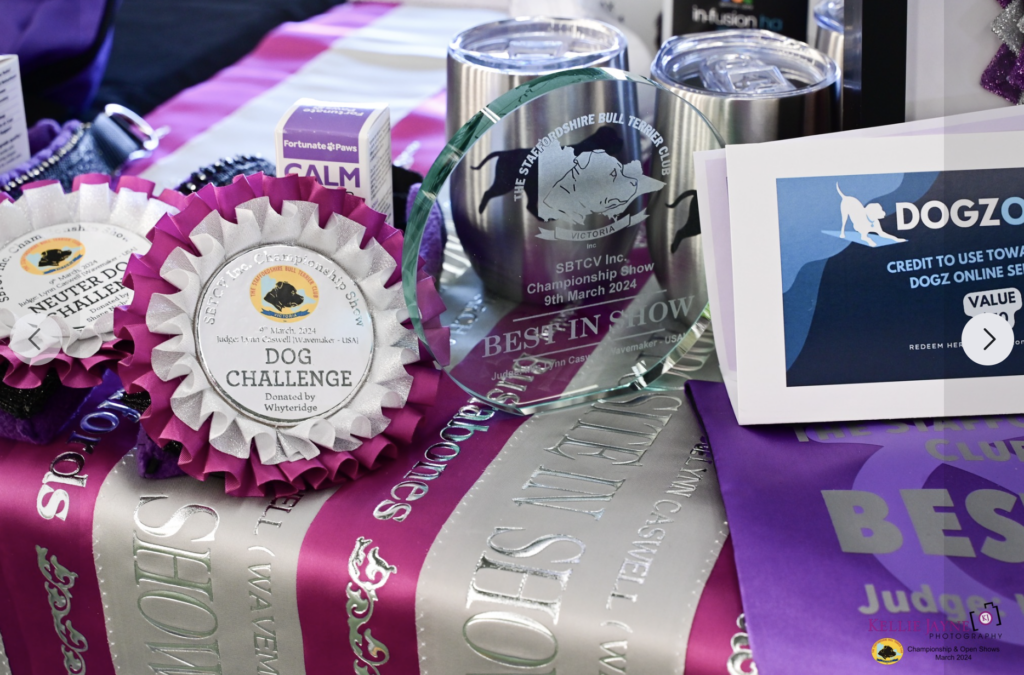
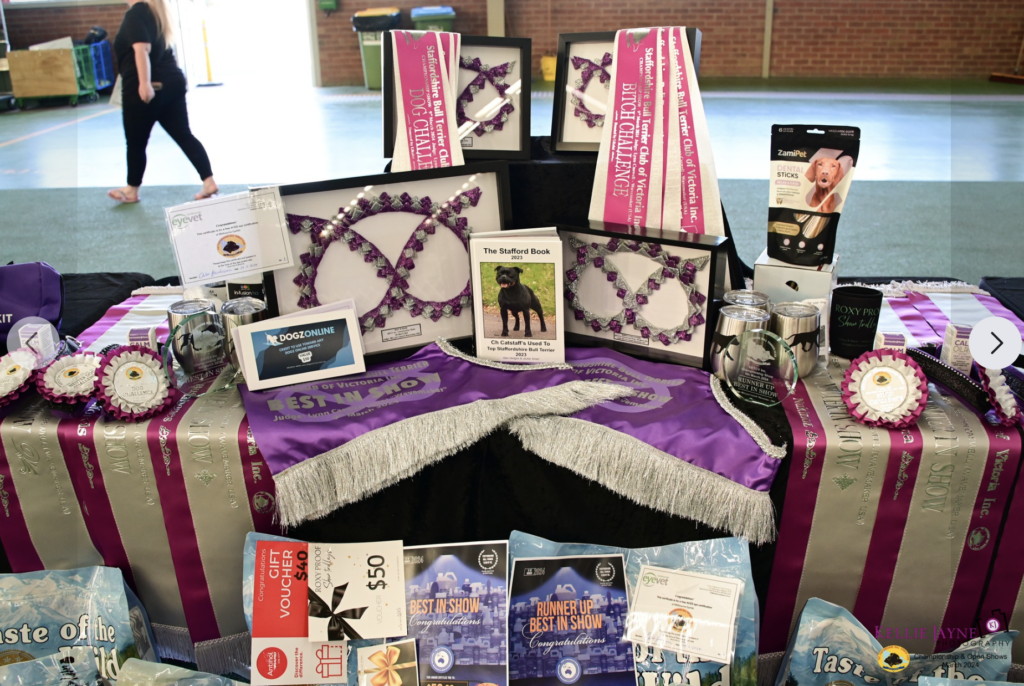
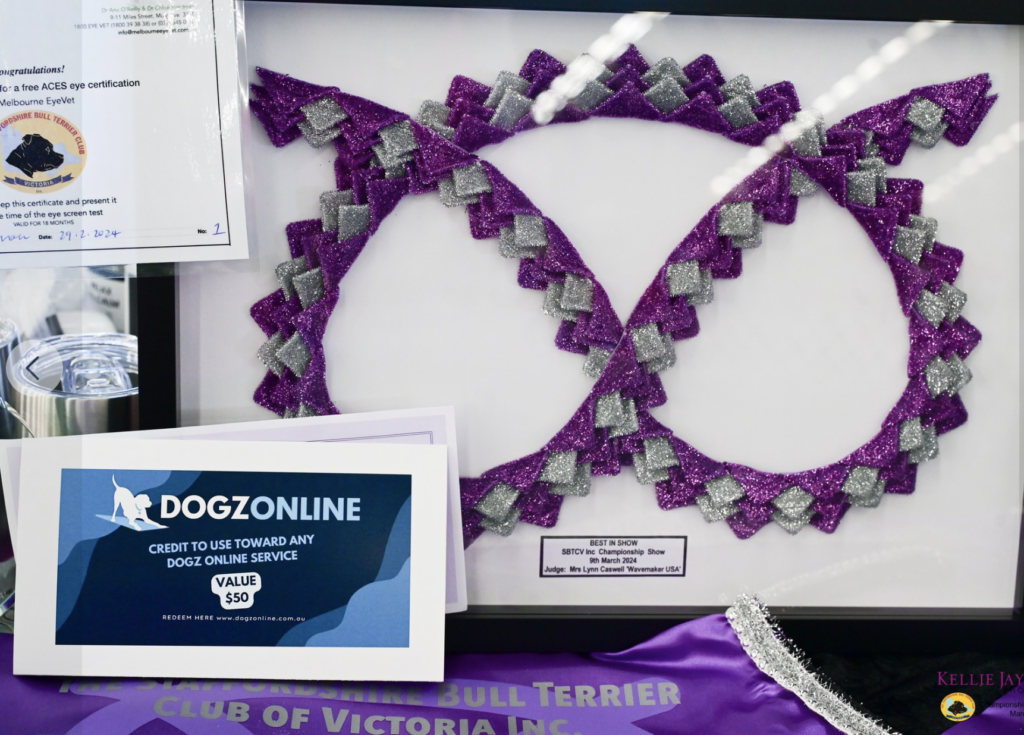
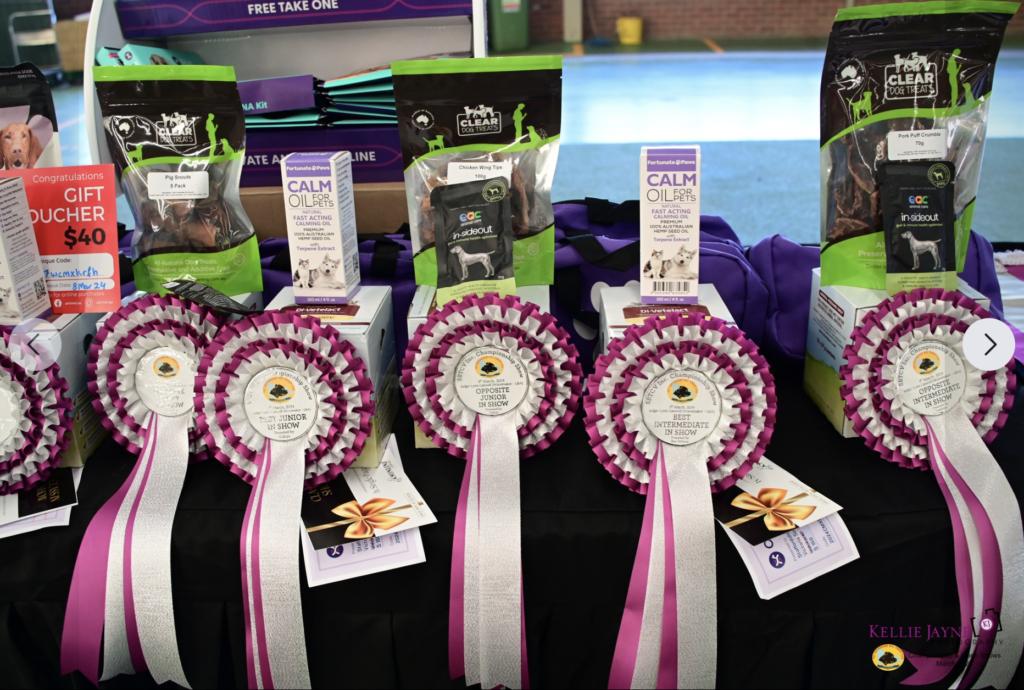
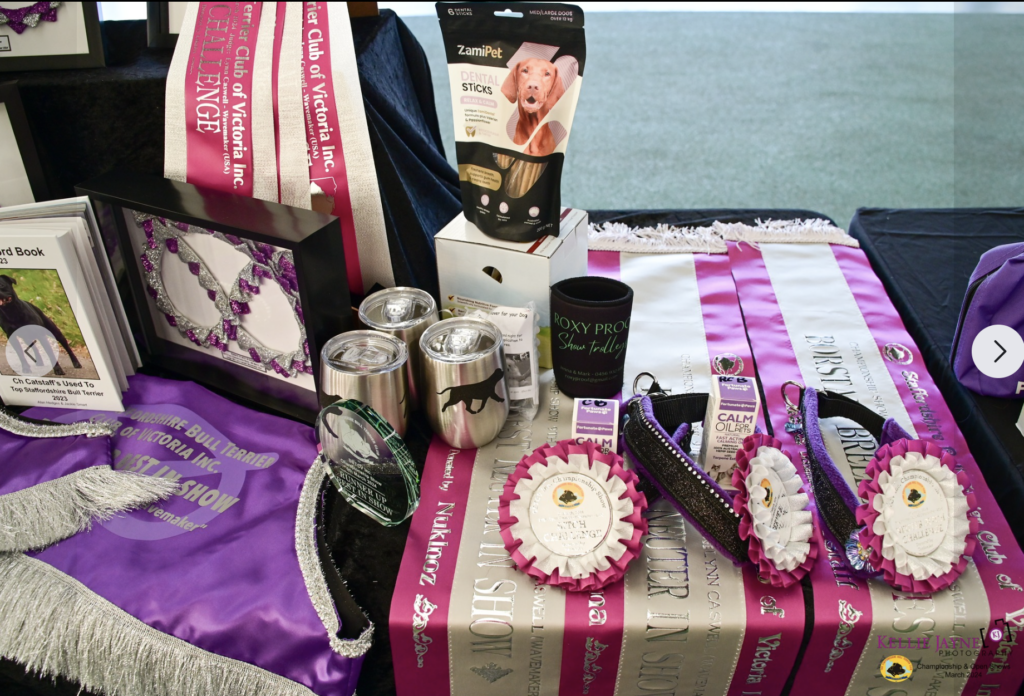
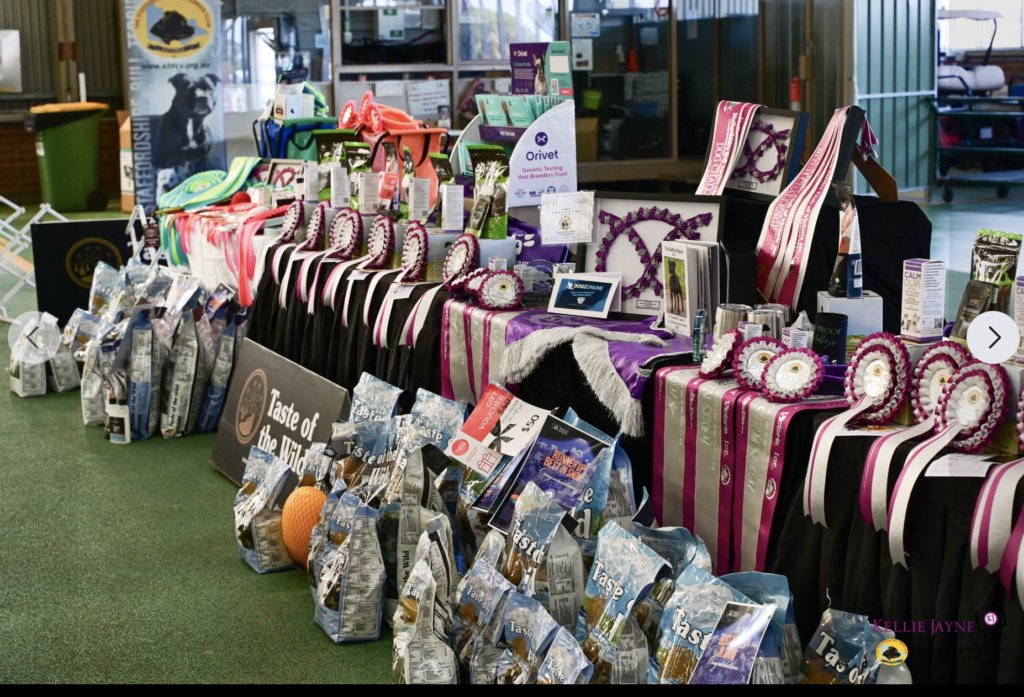
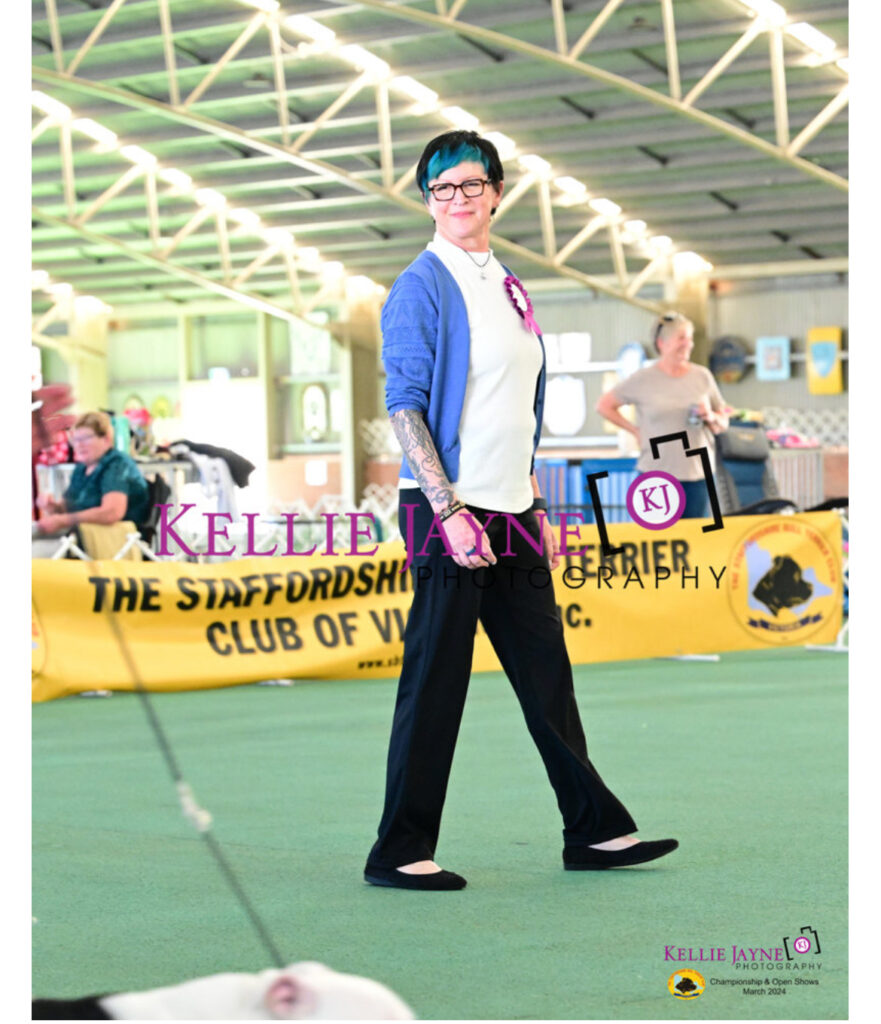
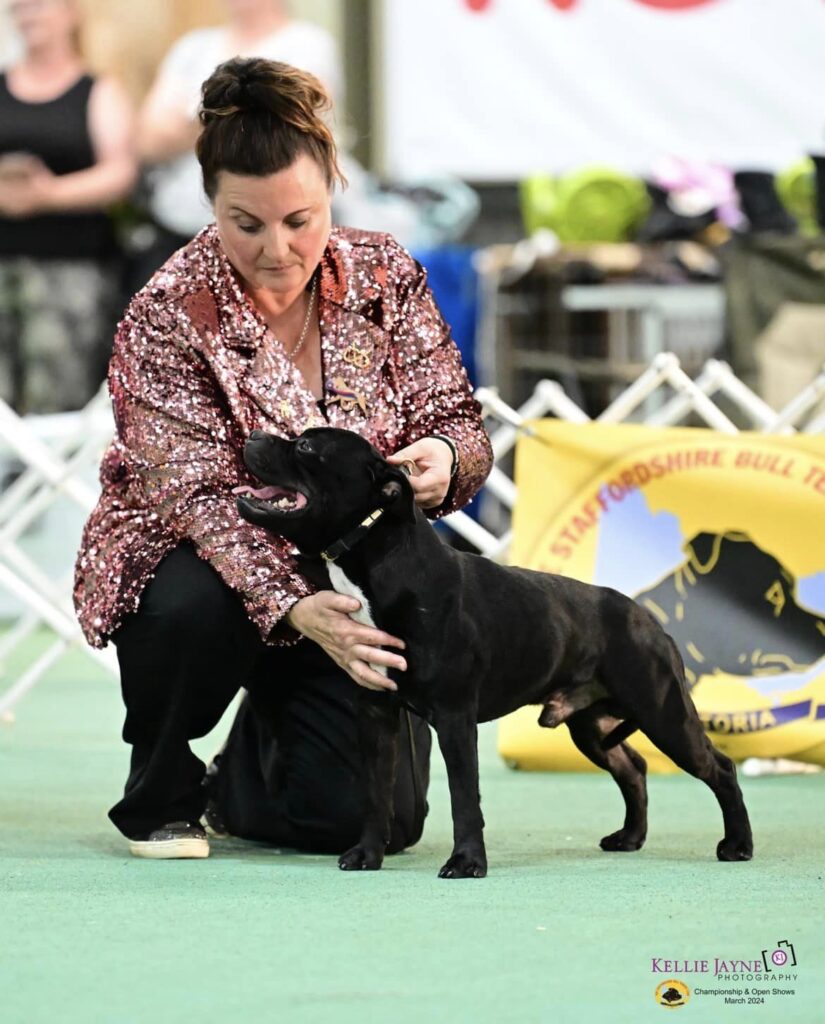
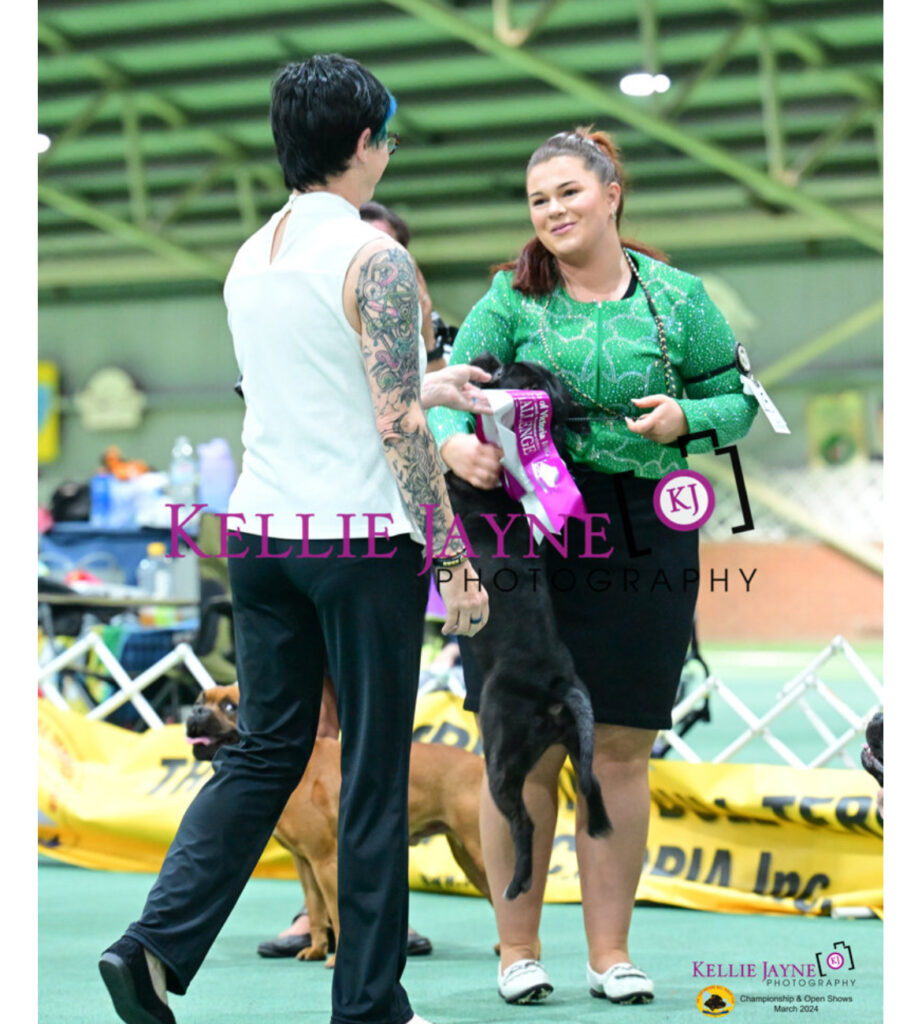
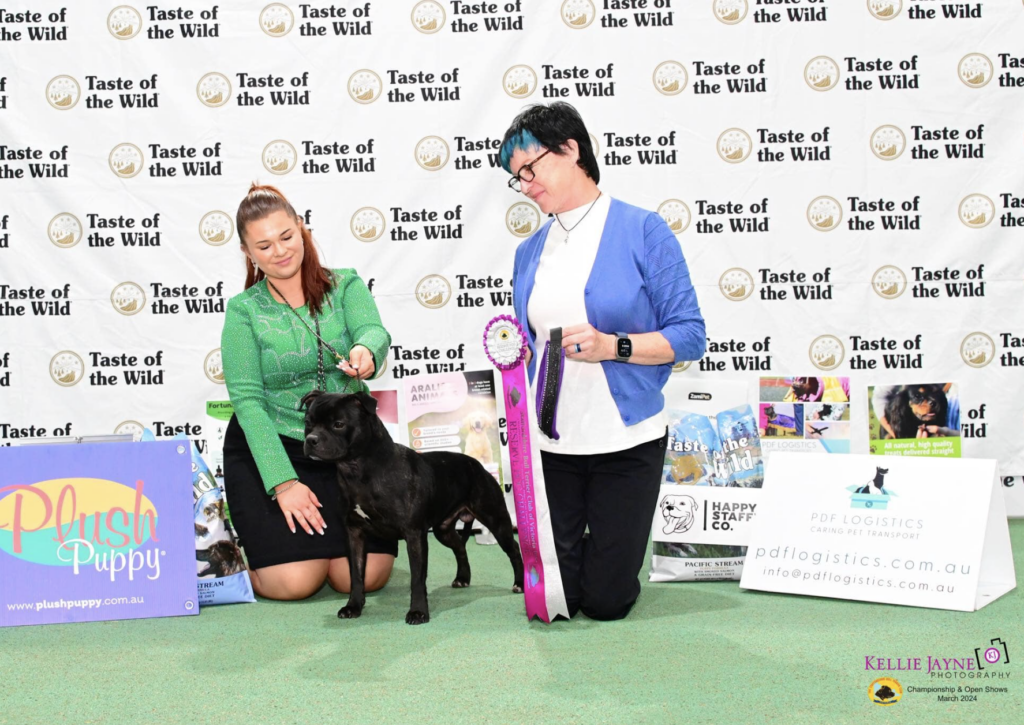
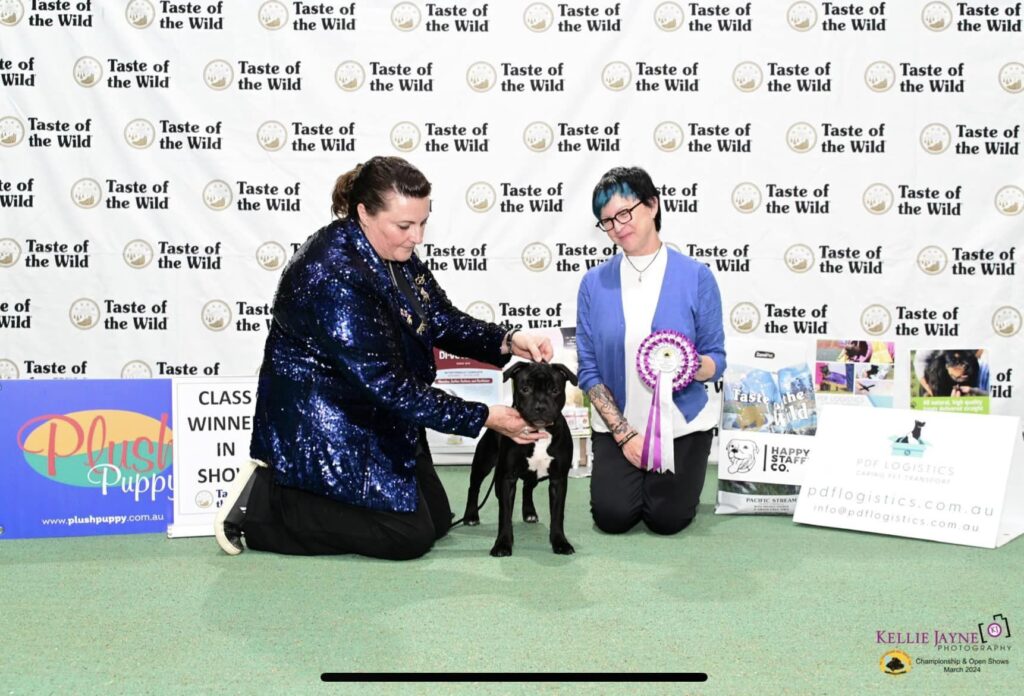
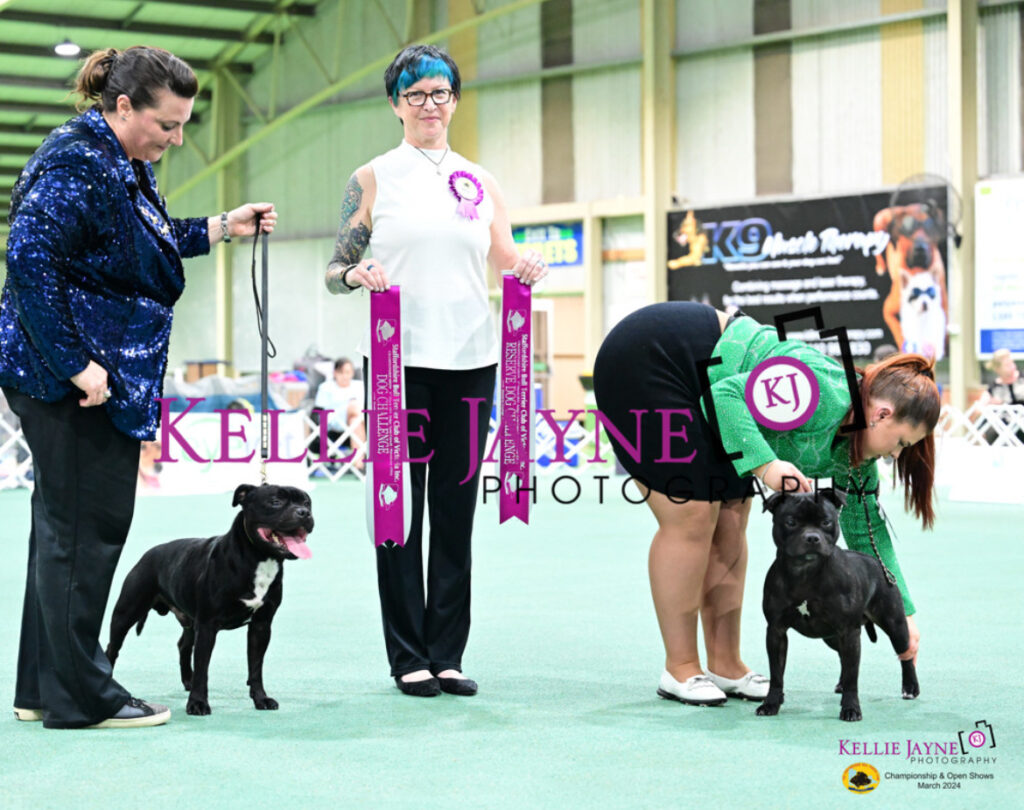
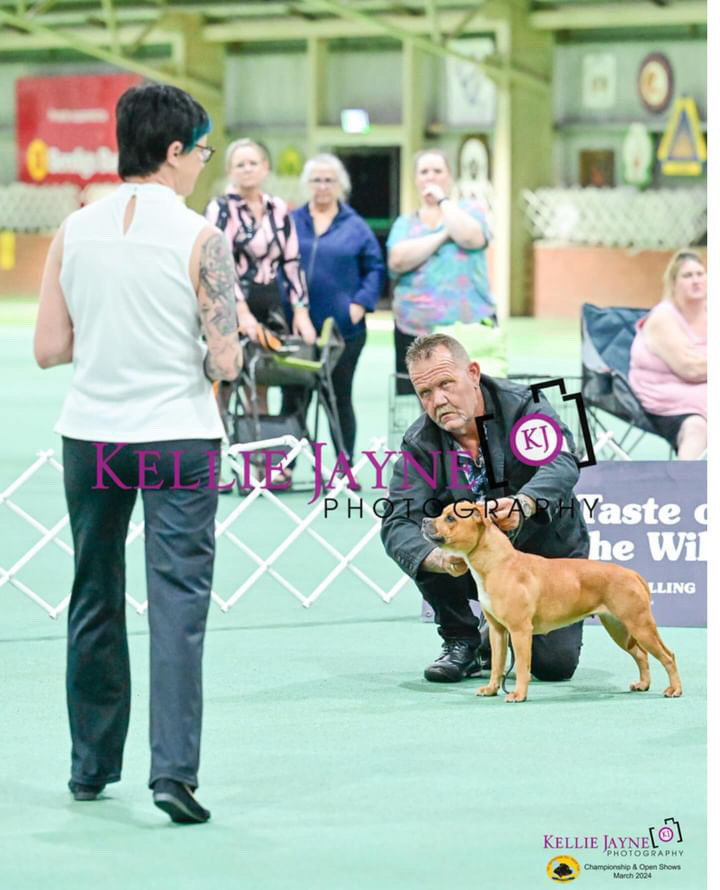
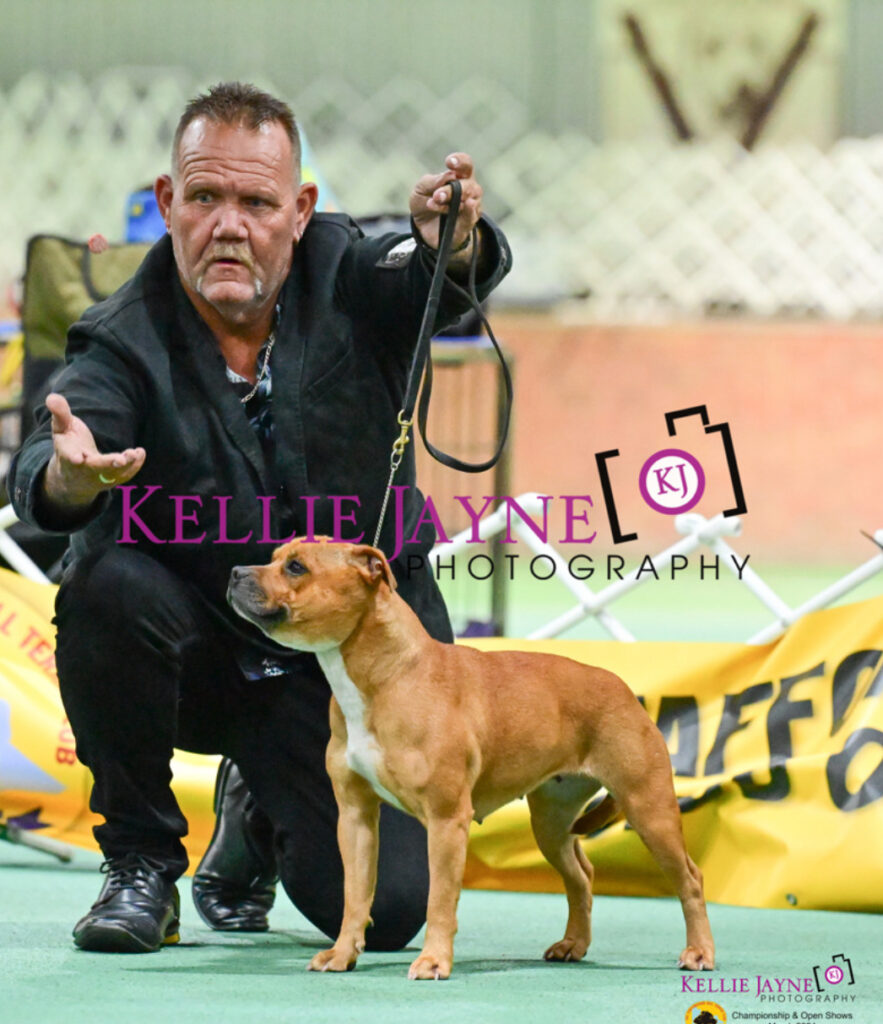
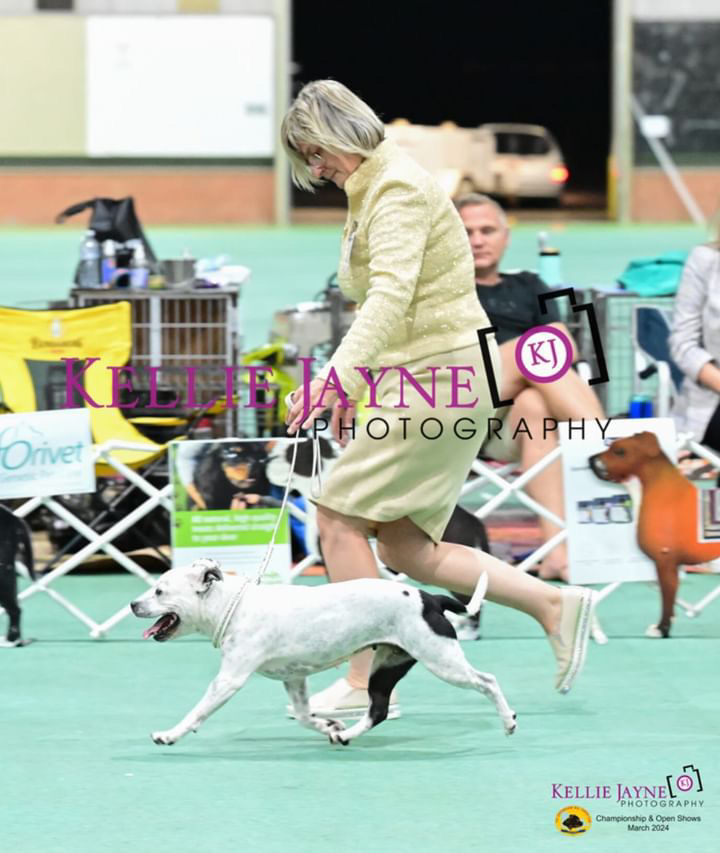
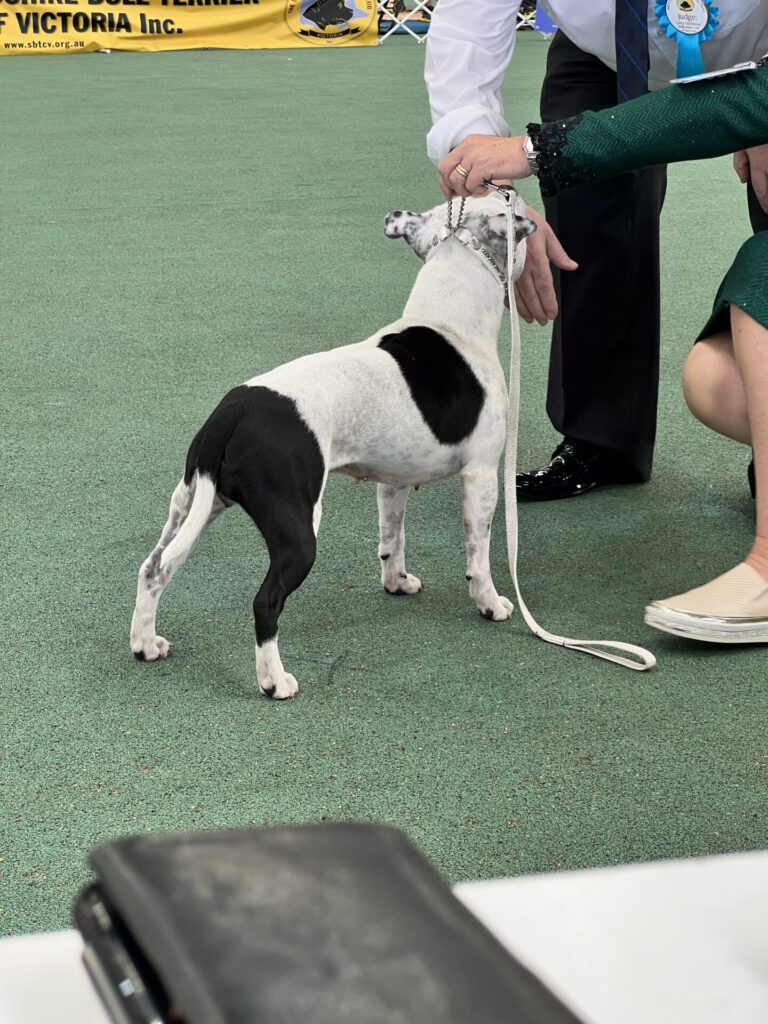
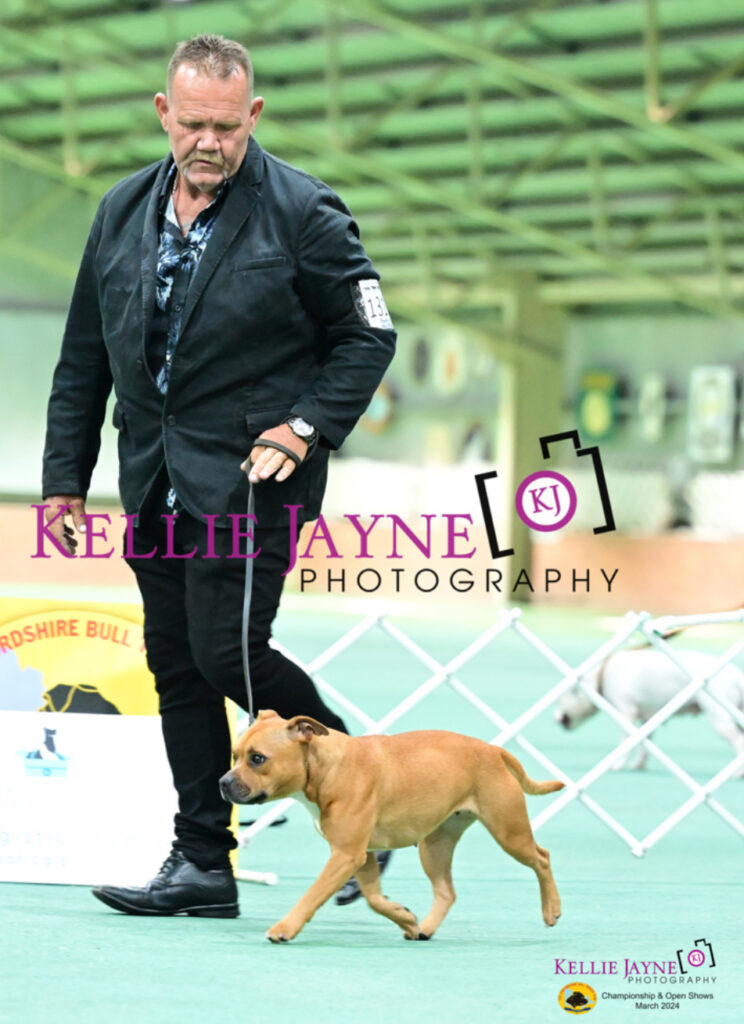
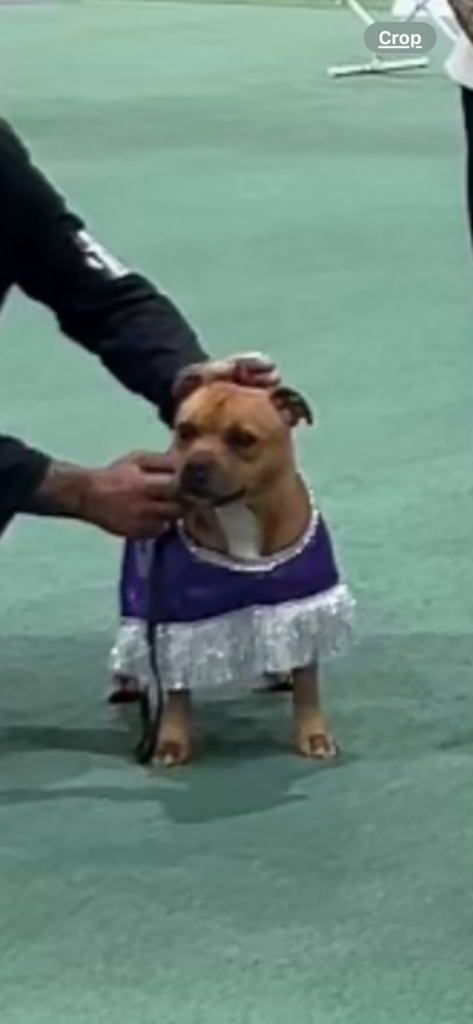
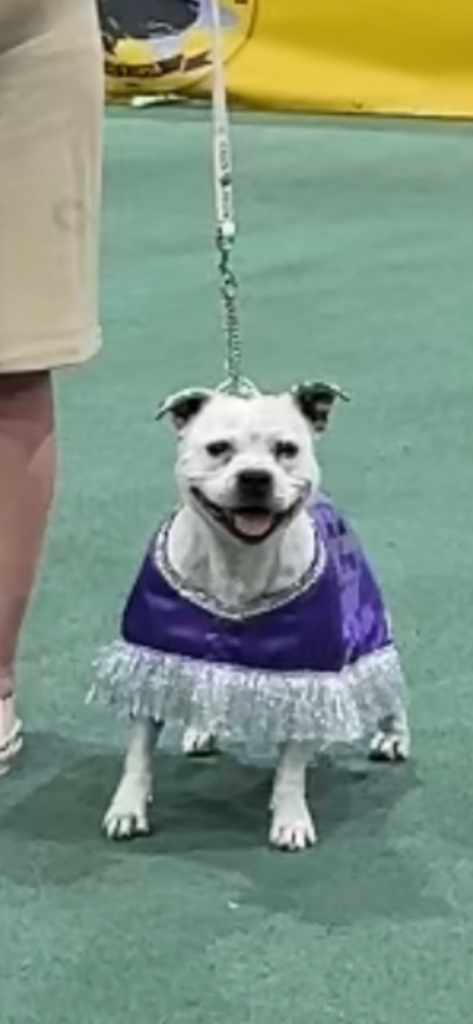
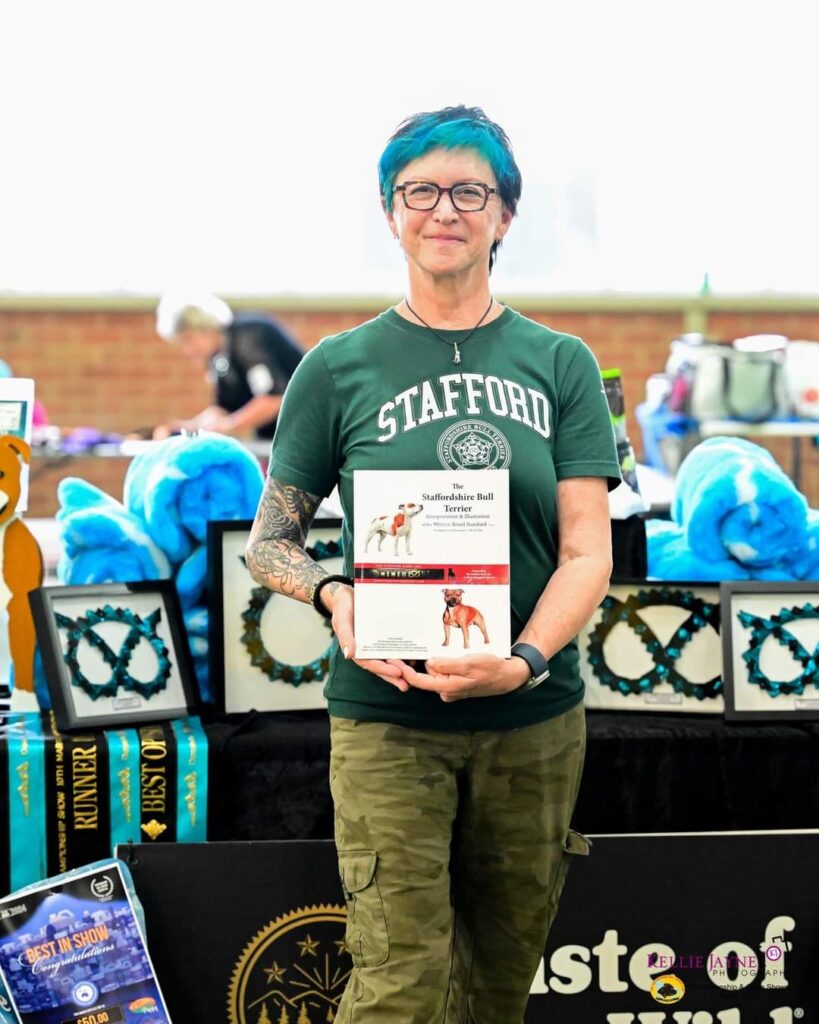
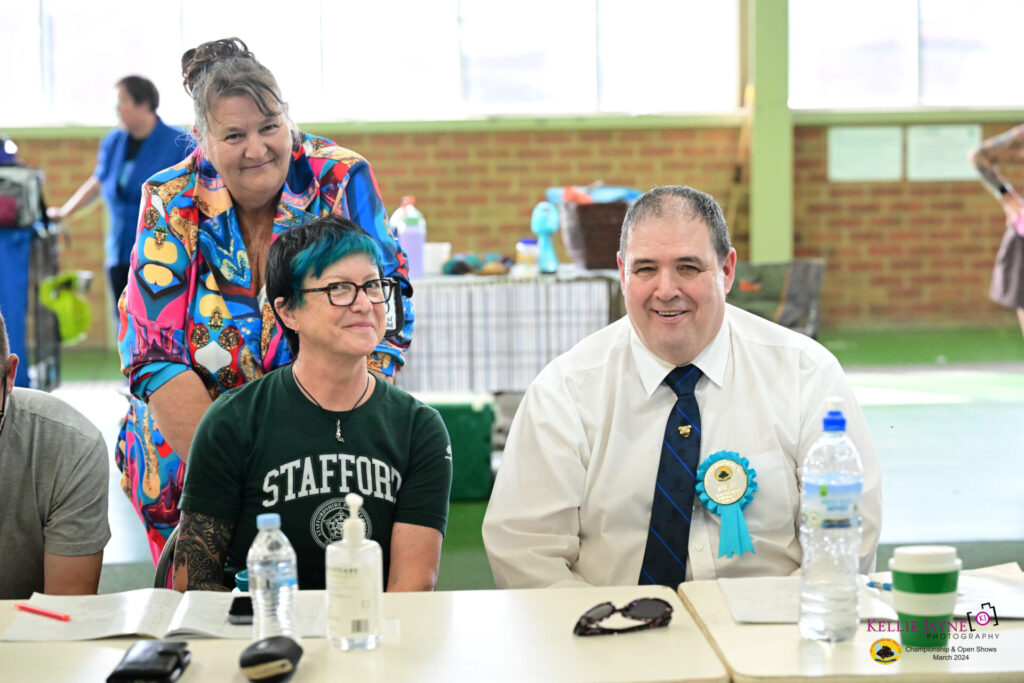
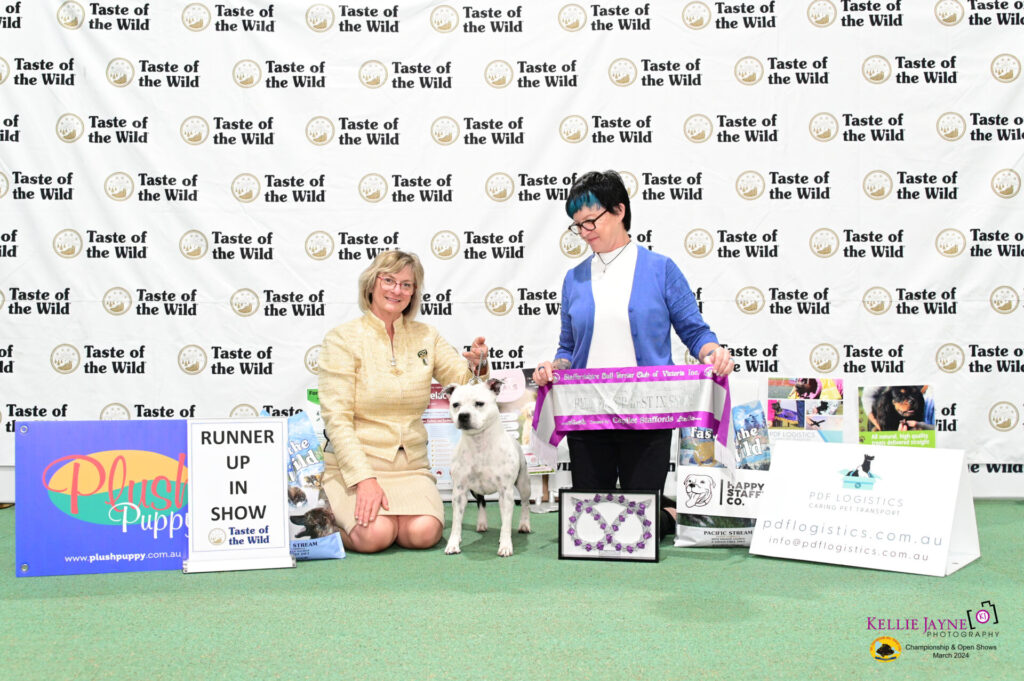
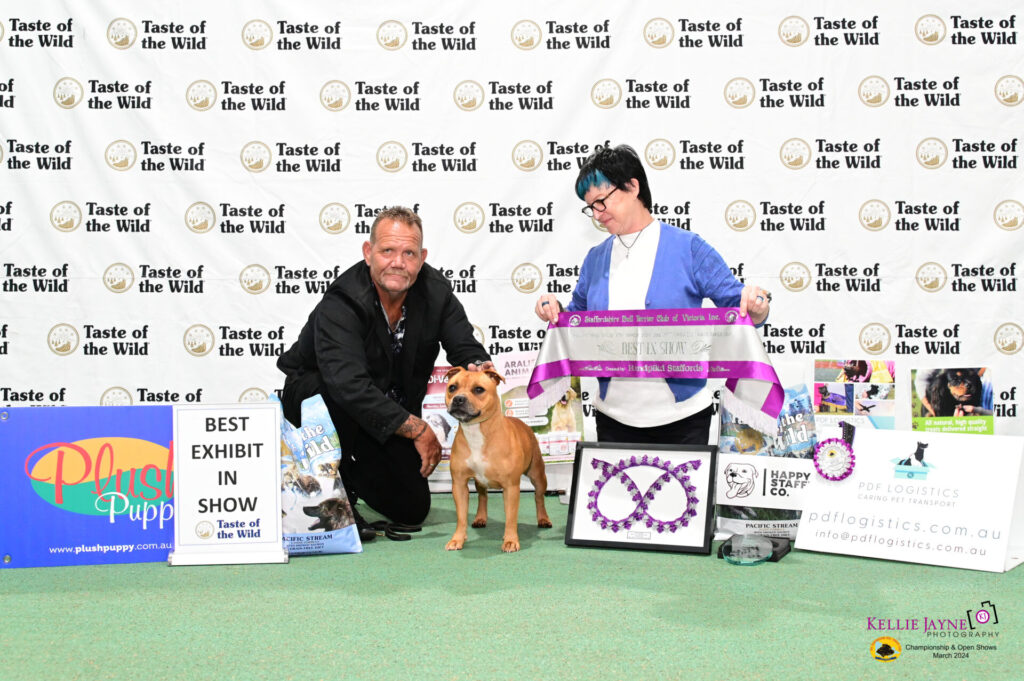
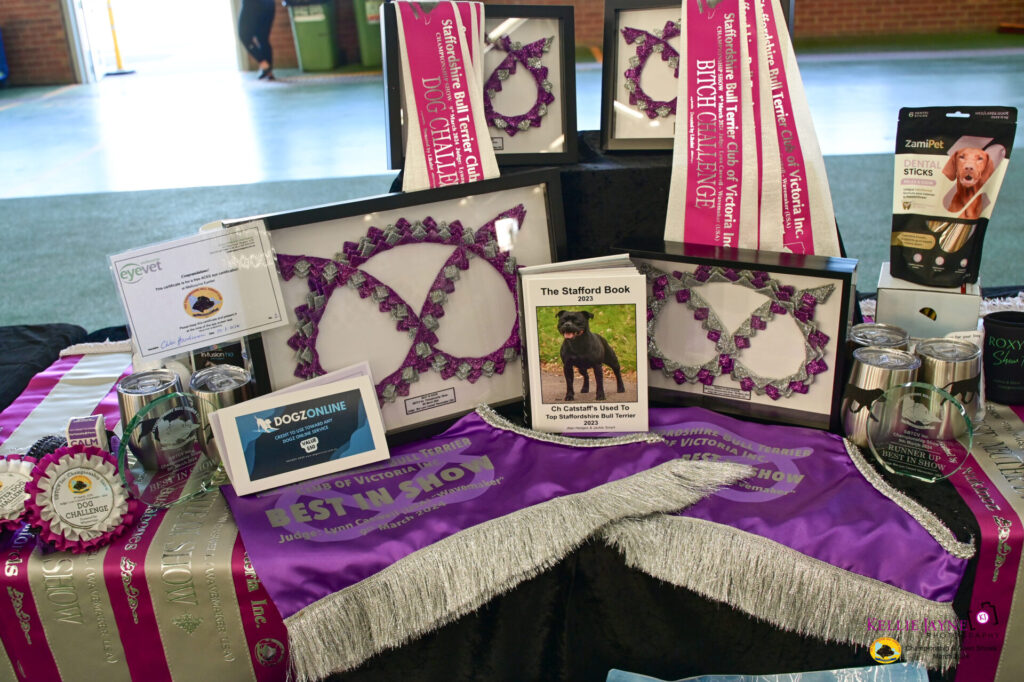
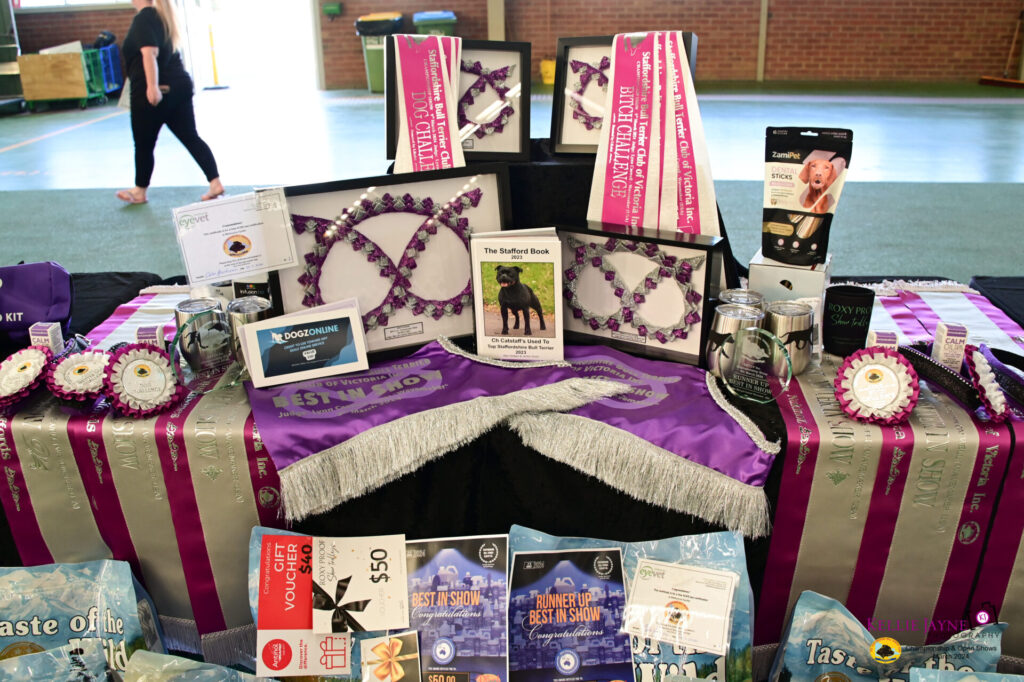
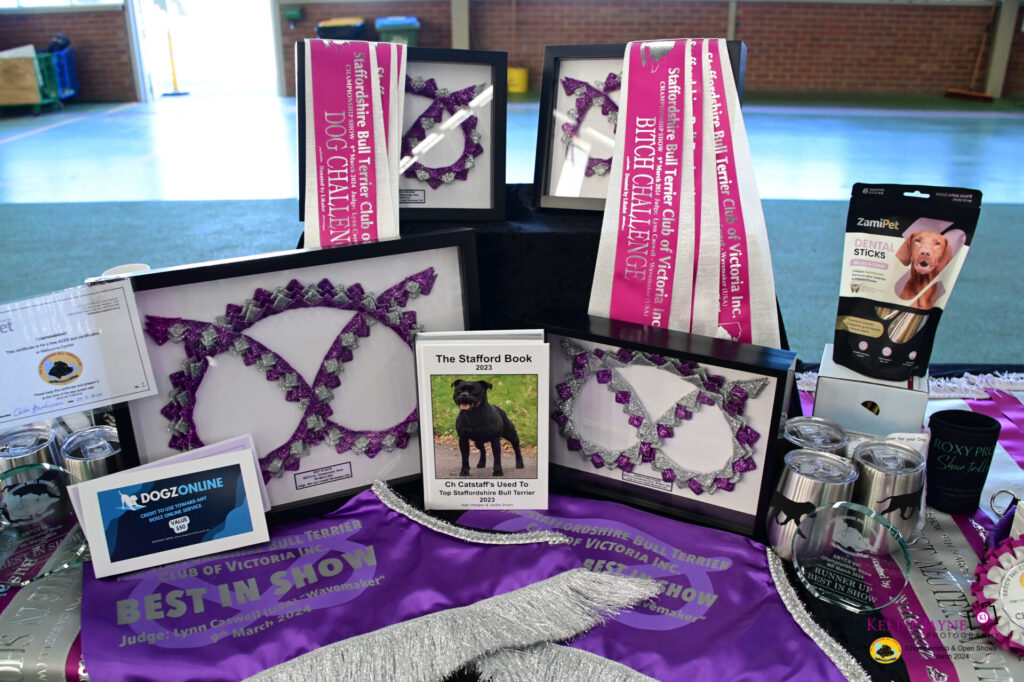
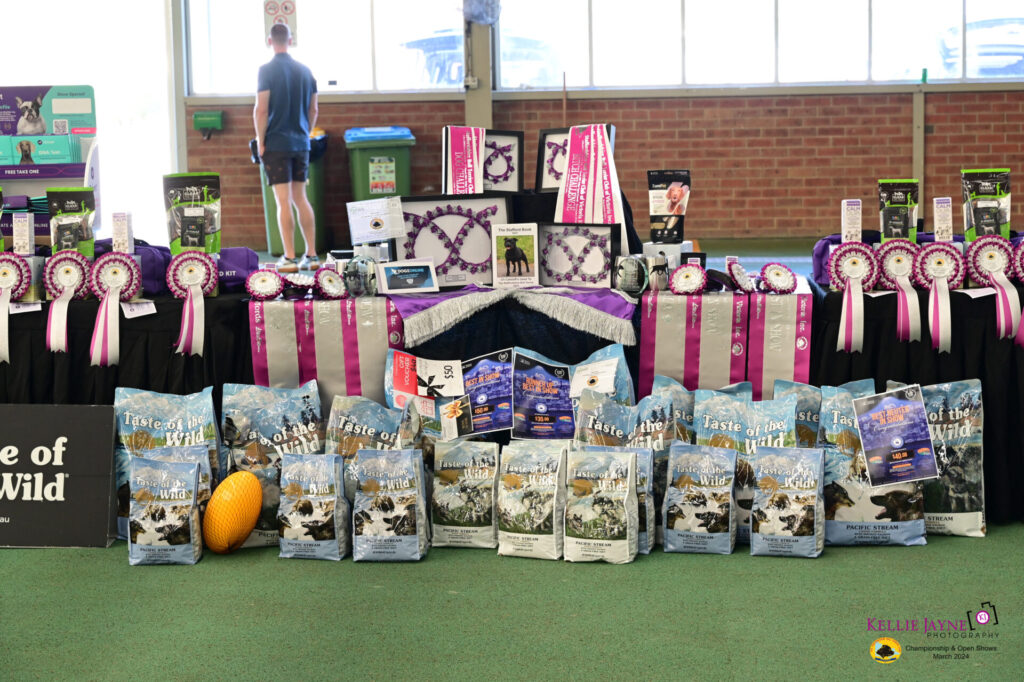
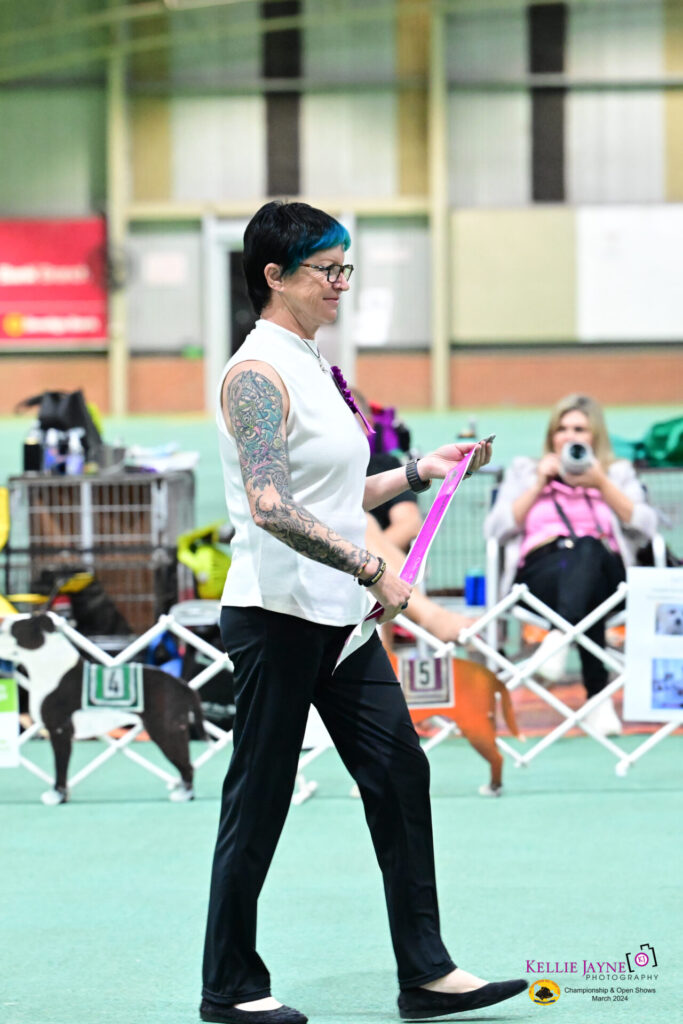
My critiques for Australia are as follows :
The Staffordshire Bull Terrier Club of Victoria
Champ Show. Friday 9th March, 2024
145 Entered/24 Absent
DOGS
Baby Puppy –
1st: #3 Mr M & Mrs J Sing – Pranksta The Equalizer (AI)
BB with white on chest and rear toes, Beautiful puppy with correct rose ears set nicely on a well developed clean head for such a youngster, fun terrier attitude showing proper courage and fearless fun, nice development already showing lots of promise. Once he got going he moved well with drive and for one so young even had a showy attitude in the ring. Easily Baby Puppy in Show.
2nd: #2 Mr J & Mrs M Meredeth – Beddah Reign Of Fire (AI)
Red and white piebald, Super dark eyes with excellent eye rim pigment, dark pigment on nose and lips as well. Good under jaw and cheek bumps for a baby, nice head shape, good bone and straight front, already showing promise at this young age.
3rd: #1 Mr J & Mrs M Meredeth -Beddah Canadian Dreams
Red and white piebald, another super bold and fearless baby puppy showing what it takes to be a Stafford, confident in himself, nice dark eyes, open nostrils and good front. Adorable and full of himself.
Minor Puppy –
1st: #5 – Mr D Yates – Tiamostaff A Knights Tale
BB, Gorgeous head with 1/3 to 2/3 muzzle to skull ratio and distinct stop showing no wrinkle, neat ears allowing for keen expression, very nice front leading to perfect feet with correct turnout, good shoulder layback and lay in, short back and level topline leading to low tail set. Short coupling. Minor Puppy in Show.
2nd: #6 Shadowstaff Kennels – Shadowstaff Shoot To Thrill
BB, Pretty head, dark eye, good muzzle, open nostril, good length of upper arm and nice shoulder layback, nice front. With a bit more ring time this promising boy should have a bright future.
Puppy –
1st: #8 David and Bronwen Livingstone – Likalot Game Over
BB and white piebald, Gorgeous headed youngster with the best of expressions, neat rose ears well set on his head, good nares, great bone, feet and front, level topline and a tail that never stopped. Easily caught my eye.
2nd: #12 Mr F & Mrs M Coetzer – Zeracious Let It Be Me
BB with flashy white markings, masculine head with tight lip, very good expression and happy attitude, good front and tight feet, confident boy who should mature into himself nicely.
3rd: #9 J.L. & A.H. Griffin – Brookstreet All Jokes Aside (AI)
Red with white chest and toes, Gorgeous head with correct proportions of muzzle to skull ratio, darkest of eyes, pretty expression, good topline, longer in body than other placers.
Junior –
1st: #17 Melissa McLean – CH. Onahi Atticus (AI)
BB with white on chest and toes, The most gorgeous head which immediately caught my eye! His front is bang on to the Standard, nice depth to his chest and plenty of width in front. Loved a lot about this boy. Topline drops a tad at the croup but doesn’t distract from his virtues, nice bend of stifle, well-conditioned, moved with purpose.
2nd: #16 K. Lacey, S. Williams, J. Lacey – Toplace Company Of Strangers
BB with white chest and toes, Super promising boy who pushed hard for first, very good clean head free from wrinkle, tight lip housing nice scissor bite, darkest of eyes and good ear placement, good front on strong pastern with tight feet. Great expression, a lot to like about this boy!
3rd: #18 Mr. L & C Doorackers – Taino My Alibi
BB, nice breed type, good pigment, good angles fore and rear, nice low tail set, sure to improve with a bit more ring experience but promising at this young age.
Intermediate –
1st: #23 Mr. M & Mrs. J Sing – CH Pranksta The Devil Has A Name (AI)
BB with white on chest, this boy caught my eye on his style and ring presence which was big! He is very balanced overall with nothing exaggerated. Love his masculine head with correct planes and proportions and especially his confident expression. Dark eye, clean lip, open nostril. Nice strong pasterns, tight feet, excellent topline. Handler got the most out of him which looked like fun. Great temperament overall! Pleased to award this handsome boy Intermediate in Show and on to my Dog Challenge Certificate.
2nd: #25 P Harrison – CH Skybreaker Not My Circus
BB with tiny white spot-on chest and on back toes, This boys head grabbed me immediately with the darkest of beautiful round eyes held on me the entire time in the ring! He seemed a bit naughty which of course appeals to my love for this breed. Perfect rose ears, dark pigment in his mouth including the roof housing a good scissor bite with wickedly large canines, wide open nostrils, Front bang on with excellent bone, good mover. This boy really pushed hard for first place in this competitive class. Happy to award him Reserve Dog CC knowing he will have a bright future ahead of him.
3rd: #20 K Roebig – CH Bxact Sumthng Wickd Thiswycoms
Brindle, Another competitive boy with a super head which I couldn’t take my eyes off of. Head planes and proportions on the money, great expression on a clean head free of wrinkle. Front straight with good bone and strong pasterns, feet turned out perfectly as asked for in Standard. Nicest of layback and lay in of scapula and level topline standing and on the move. This class was by far my most competitive one of the night and all of these boys pushed for their placements.
Graduate –
1st: #28 Ms K Stephenson – Shadowstaff Red Right Hand (AI)
Red with dark mask, top sized deep pigmented boy with a strong head and higher set ears which gave him a nice expression, evident pro sternum leading into a nice length of rib with good spring, good topline which he held on the move.
2nd: #26 Ireland – Stafflex Im Here So Move On
BB with white on chest and toes, pretty head with dark eye and nice expression. The heat was not this boys friend as it was evident he wasn’t keen on the exam portion but once he got going he settled down and moved well.
3rd: #27 Mr SP & Mrs TM Henderson – Calojo They Were Warned (AI)
Mahoghany brindle with white toes, Good length of muzzle and nice ears, straight front, moved well.
Limit –
1st: #30 Helen Lomax – Kaleida Lightnin Strikes Twice CA
White, top sized strong headed handsome boy with excellent pigment, dark round eyes well placed on a well-proportioned head, open nostrils and keen expression, nice strong masseter muscles and strong muzzle housing a good bite. Good front with correct chest and rib, well boned without being overdone, excellent condition. He was my Limit in Show.
2nd: #31 Ireland Stafflex Heskeys Journey
BB with white on chest and toes, Beautiful balanced masculine head with the best of proportions from cheek to stop to muzzle/skull ratio. Large canines and tidy ears. Short bodied with nice low tail set. Pushed hard for first placement.
3rd: #29 Debra Radcliff – Borstaff Jack None Reacher
Brindle and white split faced, Gorgeous head with strong cheek bumps, good ears, dark eyes, giving him a lovely expression, good front, correct spring of rib and depth of chest. Would love to see in fitter condition as this flashy boy has many virtues which would benefit.
Australian Bred –
1st: #44 Susan Lambert – CH Wooloostaff Devils Undeniable (AI)
BB, Dark eye leading to keen expression with a strong head. Nice front and bone with correct layback and lay in of shoulder showing no looseness at all, This boy moved really well with purpose and had correct drive from the rear. Worked well with his handler.
2nd: #38 F. McBride / L. & C. Doorackers – CH Brohez Forge Of Empires (AI)
BB with white on chest, nice stop and through of skull with strong masseter muscles and clean, but a bit shorter muzzle than first. A tad higher set ear added to his lovely expression due to his excellent and quite happy temperament he showed in the ring. Nice straight front with correct feet, well placed neck widening to good layback of shoulder. Level topline standing and on the move.
3rd: #37 Craig Heard – Toploader Brindle Hustler (AI)
BB tiny white on chest, This dog pushed hard for a higher placement and on any given day any of these three in this class could have switched places. Loved his beautifully proportioned head featuring correct planes and proportions once again. Perfect ears which he used well. Good front, nice level topline and low set tail.
Open –
1st: #51 Koendidda Kennels – CH Koendidda Onya Birri ET.
BB and white piebald, Striking dog with class and beauty. Top sized but so well-balanced , excellent head housing large canines and a scissor bite, strong cheek bumps, rose ears, dark pigment and eyes which are so important for a piebald. Straight front with correct angles and depth. Good chest and rib spring and length leading to a nice hourglass shaped figure. Good mover and terrific confident temperament. He gave his all and earned this placement from a large strong class.
2nd: #52 Linda Szirer – CH Borstaff Thunder Maker
Red with white on chest, deep dark red coat and dark eye, good head with correct length of muzzle to skull ratio, tight lip, good cheek bumps, beautiful front with enough pro sternum and strong pastern leading to nice tight well-padded feet. Good front angles with correct length of upper arm and nice rear angles helped him move with purpose. Would love to see a bit more conditioning to help define his many virtues better.
3rd: #60 Ms N Yates – CH Brohez Watcher On The Wall (AI)
BB with a little white on chest, nice balanced standard dog with plenty of virtue to appreciate! Good head, correct front, good depth of chest and plenty of rib spring. Correct sternum length, correct loin and nice rear. Good tail set and lovely confident happy temperament.
Neuter –
1st: #137 Mr S P & Mrs T M Henderson – CH NEUT. CH Calojo The Big Bang (AI)
Brindle with white chest and toes, gorgeous deep mahogany coloring, top sized boy with good cheek muscle a clean strong head with nice length of muzzle, nice front, good topline and rear with good bend of stifle, moves very well.
2nd: #136 Donna Treadwell – NEUT CH Kimbastaff Dooin It Solo
BB, Handsome classy in Standard boy with a nice clean head with wide open nostrils and dark eye, very good front showing good pro-sternum, nice angles front and rear, moved well with his handler. Pushed hard for first place getter and could exchange places on any day.
3rd: #138 Mrs C Sorensen – Keelford Zeppelins Demise WWPD JC
Red with white on chest, Lovely frosted faced top sized gentleman with the gentlest attitude, nice dark round eyes giving the sweetest of expressions, good angles front and rear.
————————————————————————
BITCHES
Baby Puppy –
1st: #64 Mr J & Mrs M Meredith – Beddah Elegant And Sassy (AI)
Red/white piebald, clean head, distinct stop, good pigment, dark eye, correct length of neck with gradual widening leading towards well laid-back shoulder, good fore chest, short coupling with correct low tail set and good rear angulation.
2nd: #65 Mr M & Mrs J Sing – Pranksta Cilla Black (AI)
BB with beautiful clean head with correct head planes, nice rose ears, good straight front with correct pro-sternum development, ample bone, short coupling leading to well angled rear, perfect tight feet.
3rd: #68 Mrs A Wolf – Ourgang Untold Gold
Red with white toes and chest markings, dark pigment, tight lip, a bit larger than first two placements, correct front with strong pastern, beautiful level topline with correct low tailset and good rear angles.
Minor Puppy –
1st: #71 Annabel Wolf – Ourgang Unbelievable
BB, Beautifully balanced very promising young bitch, gorgeous head with distinct stop and very dark eyes, no wrinkle, Feminine expression you simply cannot miss, stands on strong front pastern and good bend of stifle with well boned legs in a perfectly balanced four squared manner. Fantastic expression.
2nd: #73 Mrs L Szirer – Borstaff Look At Moi
Red/White pied with head showing strong masseter muscles already for such a youngster, dark eyes with good expression, level topline, good front with a tad less pro-sternum than 1st place puppy but beautifully balanced coming and going. Worked well with handler.
3rd: #74 Ms D & K Edwards – Sookalott Star Struck
BB, stronger headed puppy who is well put together, lovely ears and neck, correct tail set and one who will find her way with a bit more practice.
Puppy –
1st: #85 S Clark & D Major – Kabere Faith Trust & Firedust (AI)
BB, distinct stop, darkest of eyes, ears a bit higher set but she used them perfectly to show alert expression, I loved how she showed her character in her ring presence, nice straight beautiful front on strong pastern with feet turning out as expected, nice topline, short. Promising puppy and in fact was Puppy in Show.
2nd: #80 Miss A Freeman – Echostaff Last Temptation
Red with white socks and chest/neck, This girl caught my eye with her beautiful front and topline, correct tail carriage, good rear angles, stronger head than 1st but good dark pigment and neat ears. She was alert and keen on her surroundings and has a bright future.
3rd: #77 David & Bronwen Livingstone – Likalot I Made you Look
BB with white on rear toes and one front toe, nice length of neck gradually widening into well laid back shoulder, lovely mover on beautiful tight feet.
Junior –
1st: #95 Ms J & Miss K Lacey – Toplace Im Gonna Getcha Good
BB tiny white on chest and toes, I fell in love with this young bitch the moment she entered the ring. She is so clean and balanced and well in Standard in so many ways. Beautiful feminine head with everything text book about it. Gorgeous front including correct pastern, great feet with plenty of padding and correct turnout, nice short coupling, good rear. Shown in excellent condition for her young age. Her movement won her placement on the day. She definitely has a bright future and won’t go unnoticed by many. Easily was my Junior in Show and well deserved!
2nd: #91 Mr S P & Mrs T M Henderson – CH Calojo My Little Rain Cloud (AI)
White, Nice feminine young girl with very good head proportions, nice rose ears, dark eyes, correct neck placement widening to good shoulder layback and straight front. Nice rear angles and low tail set and carriage. Very nice mover showing plenty of drive from the rear. Held topline on the move.
3rd: #88 Katrina Coulson – Lilrock Never Da Devil
BB with white on chest, very feminine young girl with beautiful features including soft expression on a pretty head. Good ears and muzzle to head ratio. Nice front and feet, good conditioning for a youngster. She was happy and confident and worked really well with her handler.
Intermediate –
1st: #102 Koendidda Kennels – CH Jonthill Buckle Up Buttercup (AI) RN
Red, This top sized bitch has beautiful deep red coloring and the best personality demanding your attention the entire time in the ring. She is perfectly balanced and has gorgeous breed type. I love her intent connection with her handler using her dark eyes and perfect ears to show confidence and femininity. She is in excellent condition with long resilient hard muscles without being bunchy or overdone in the least.
2nd: #98 Craig Heard – Toploader Black Chrome (AI)
BB tiny white on fore chest, Good in standard bitch with excellent expression. Nice feminine head. Pretty front showing no weakness at pastern, good tight feet with nice padding, moved well and was happy to be there. Excellent conditioning with long resilient muscle.
3rd: #100 K Roebig – CH Bxact The Knockout
Red with small white on chest, Striking, yet feminine bitch in excellent hard fit condition but not overdone in the least. Clean head with no wrinkle, good muzzle housing nice bite, used her rose ears to her best showing her wonderful temperament, good mover. Pushed hard for further placement in this class.
Graduate –
1st: #111 Mr G & Mrs A Linsey – Borstaff Maggie May
Brindle with white neck, blaze and feet, This was another tough class but this girl stood out. Not only for her flash but for her wonderful terrier attitude. Feminine head, clean and free of wrinkle, framed by good ears which added to her expression nicely. Her low set tail never stopped moving and she gave her handler a workout for certain. She went on to Graduate in Show.
2nd: #113 Shadowstaff Kennels – Shadowstaff All Eyes On Us (AI)
Red with dark mask, Gorgeous feminine and very fit top sized girl with very good angles front and rear, nice muzzle to skull ratio, head without wrinkle, moved well and had correct low set tail with good carriage.
3rd: #109 K Roebig – Bxact Mistress Of Make Believe
Brindle with small white patch on chest, This fun girl was a spitfire and made her handler work, just as I like them to be! She has the prettiest of heads with near perfect proportions, in good shape and happy to be there.
Limit –
1st: #115 Ms N Yates – Yakindow Crazy Diamond (AI)
BB with small white patch on chest, Pretty very feminine head, good front and depth of chest, rib case well sprung leading to nice short loin, great topline which she held standing and on the move, good rear angles showing well bent stifle and low set hock. Good tail set and carriage.
2nd: #116 Shadowstaff Kennels – Shadowstaff Paint It Black (AI)
BB, super happy girl, higher set ears but added character to her pretty head with a distinct stop and lovely expression. Good angles front and rear.
3rd: #114 Miss TJ Amos – Verysharp Vision In Black (AI)
BB, Short back, strong deep chest, gorgeous conditioning, good bend of stifle.
Australian Bred –
1st: #123 Ms F McBride – CH Brohez Queens Gambit (AI)
BB with small white on neck, chest and toes, Very classic style with good width to her muzzle leading to great fill below round eyes and distinct stop, excellent cheek bumps, expressive ears used well, good width to her front with well-boned legs representing columns of support leading to correct foot turnout. Nice short body, good level topline and good mover. Pleased to award Australian Bred in Show.
2nd: #124 Ms S McQuade – CH Waurstafford Eyes On You
Red white piebald, Very feminine and correct head with dark eyes and no wrinkle, good mouth, nice bone and correct straight front with slight turnout of feet. Correct depth of chest and rib spring leading to nice tuck up. Croup of correct angle helping with movement.
3rd: #120 K Roebig – CH Bxact Shake Datazz Forme
Red with white on chest and toes, good head with dark pigment, nice ears, wide open nostrils, level topline, nice conditioning, happy girl.
Open –
1st: #131 Mr Greg Brooks – CH Cyprustaff Villian In Disguise
Red with white on chest, Gorgeous balanced and feminine girl with so much attitude demanding my attention the moment she entered the ring. Loved how fit and well-conditioned she was showing no extremes at all. Pretty feminine head with great ear shape and placement which helped express her “terrier-ness”. Her head planes and ratios are spot on Standard, beautiful neck and fore chest, excellent layback and lay-in of scapula and equal length of upper arm allowed for her clean front movement. Tight well-padded feet, level topline, strong rear with low set well carried tail and good rear angles. Pleased to award her Open in Show and on to the Bitch CC and Best In Show.
2nd: #132 Mrs A Dean & Mr G Bator – CH Handpikd Miss Bombay
BB and white piebald, Such attitude this girl showed! So full of character and in tune with her handler! Gorgeous strong but feminine head, great masseter muscles, good stop, with excellent proportions and good strong muzzle housing a correct bite, dark pigment, strong neck, good topline, excellent conditioning and nothing exaggerated. Held her topline on the move. She was my Reserve Bitch CC and Runner Up Best in Show.
3rd: #135 Ms L K Reid – AUST SUP CH Zeracious Sudden Impact
White, Standard sized bitch with a very nice head with gorgeous expression, good front, level topline and very good angles both front and rear which carried her well on the move. Good fitness level!
Neuter –
1st: #140 Koendidda Kennels – Koendidda Dilly Dally JC. RA.
BB, Beautiful frosted faced very feminine bitch with the tightest of lips, clean head free of wrinkle, perfect length of muzzle and gorgeous dark eyes. Nice pro-sternum on a strong front with good width of chest and strong columns of support, good topline and stands four square on her own. Happy to award Neuter in Show.
2nd: #142 Mrs A Dean & Mr G Bator – GR CH NEUT CH Handpikd Queen Of Diamonds
BB and white piebald, Such a beautiful clean feminine head with just enough flash to catch your eye, gorgeous clean and balanced body all the way around, nice topline and good angles. Another who stood four square without assistance.
3rd: #144 Ms N Yates – N CH Brohez Protector Of The realm (AI)
BB, Very feminine bitch with pretty head, good angles and terrier attitude.
Mainland Staffordshire Bull Terrier Society
Trophy Show. Saturday 16th March, 2024
40 Entered/8 Absent
What a wonderful experience traveling to beautiful New Zealand to judge your Staffords was for me. I was so honored to have been invited and was happy to see your beautiful country and Staffords. We were so well taken care of with spectacular accommodations with Kathy and Grant at their gorgeous B&B. Thank you to the committee members for putting on a wonderful show. Your hard work really paid off. We could not have asked for a more perfect day to hold this event under blue skies and sunshine. Thank you to my ring steward, Kathryn, who kept everything running smoothly and efficiently. Special thank you also to Leana and Tim for sharing their home with us and Gary after the shows. We had many laughs and saw some beautiful parts of the area.
The quality of your Staffords is to be commended with most being in fit condition and in Standard size, with only a few exceptions. I saw several in exceptional condition and to those owners you are to be commended as I know what that takes to maintain. I only saw a couple of mouth faults, converging canines mainly. Please keep this in mind as it can lead to health issues. The quality of exhibits as far as closely meeting the Breed Standard was equal dogs and bitches as I saw it. I know its probably a bit more complicated maintaining strong pedigrees when you are more isolated, but from what I saw it seems that by the careful usage of both AI and importation you are finding success. Continue on in this manner and you will continue improving and having quality Staffords. I saw some truly lovely, typey Staffords in my ring.
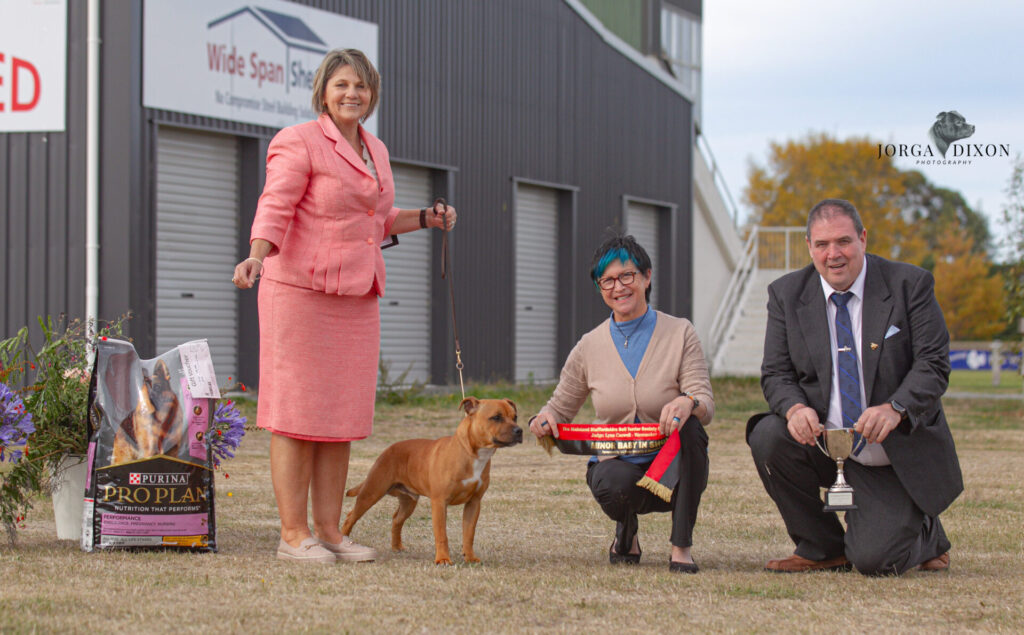
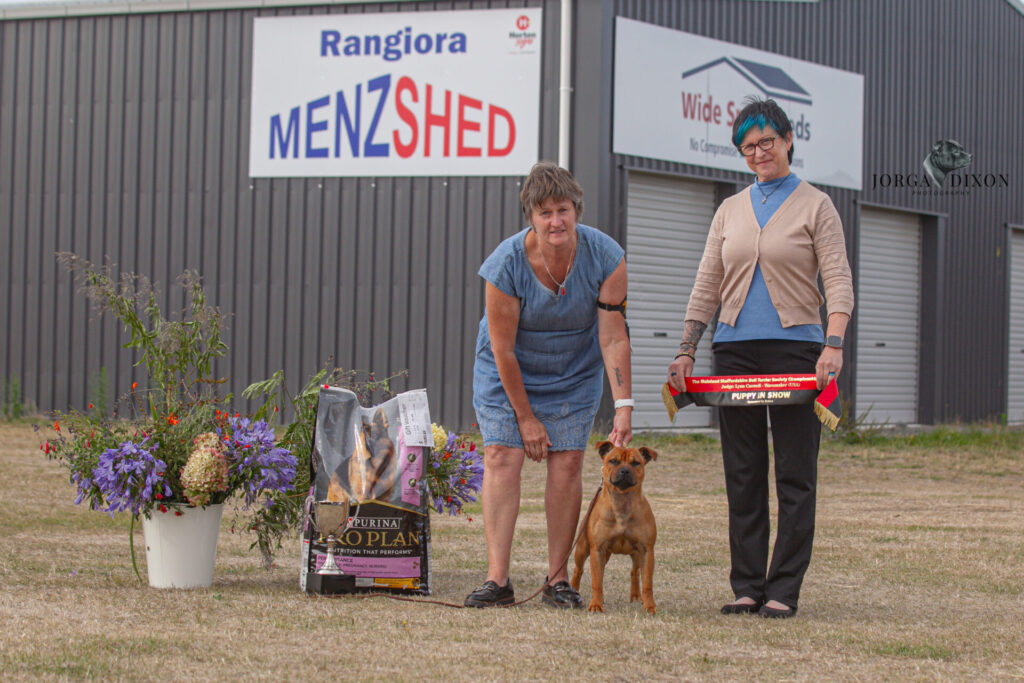
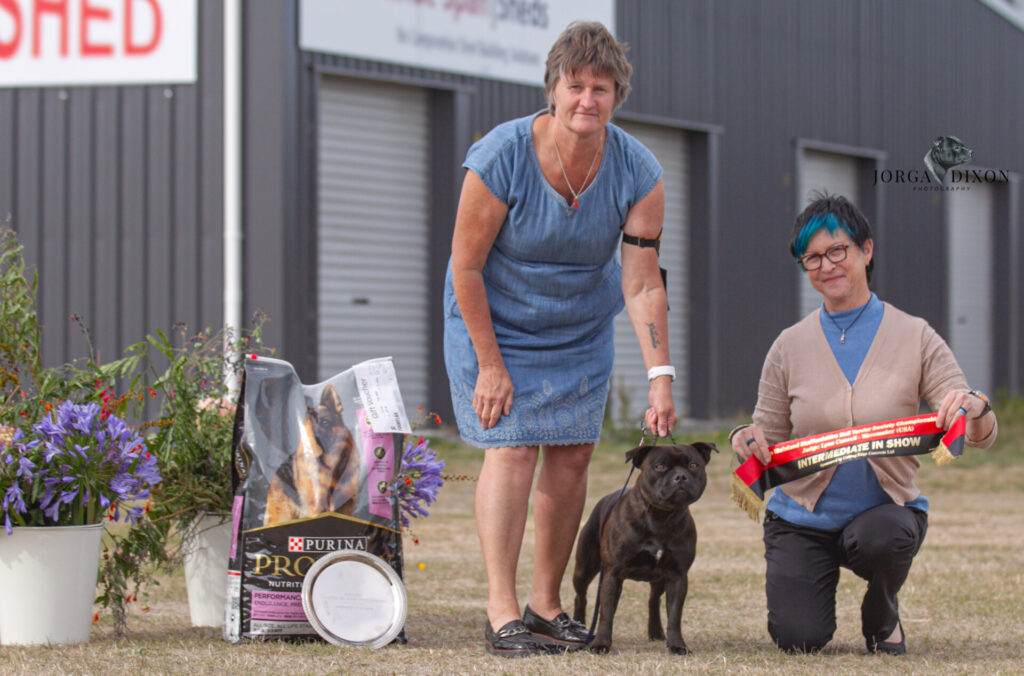
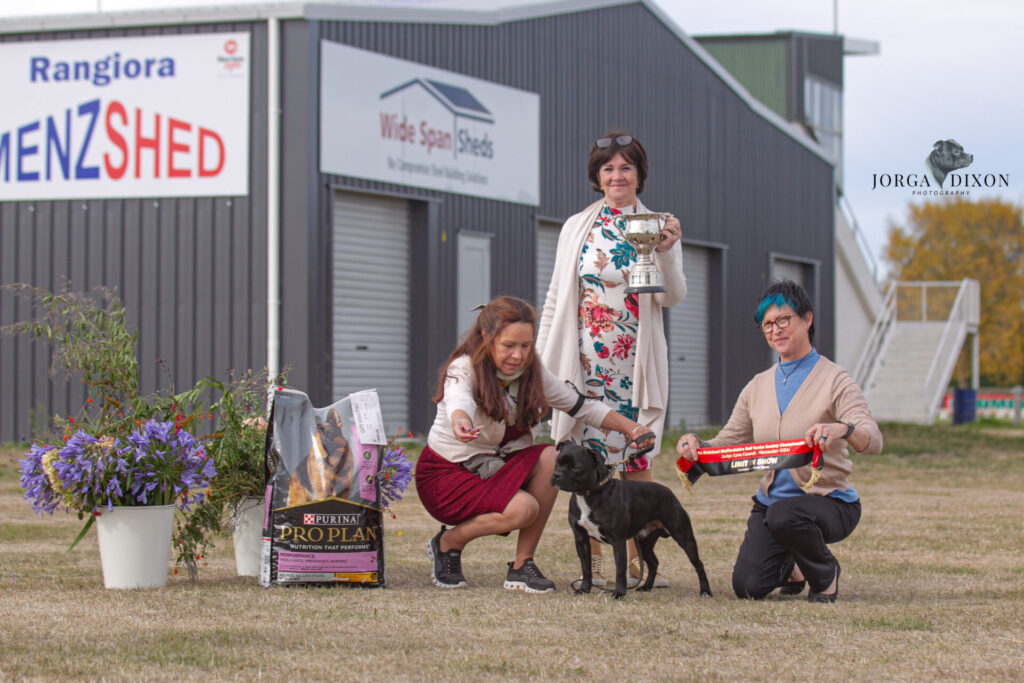
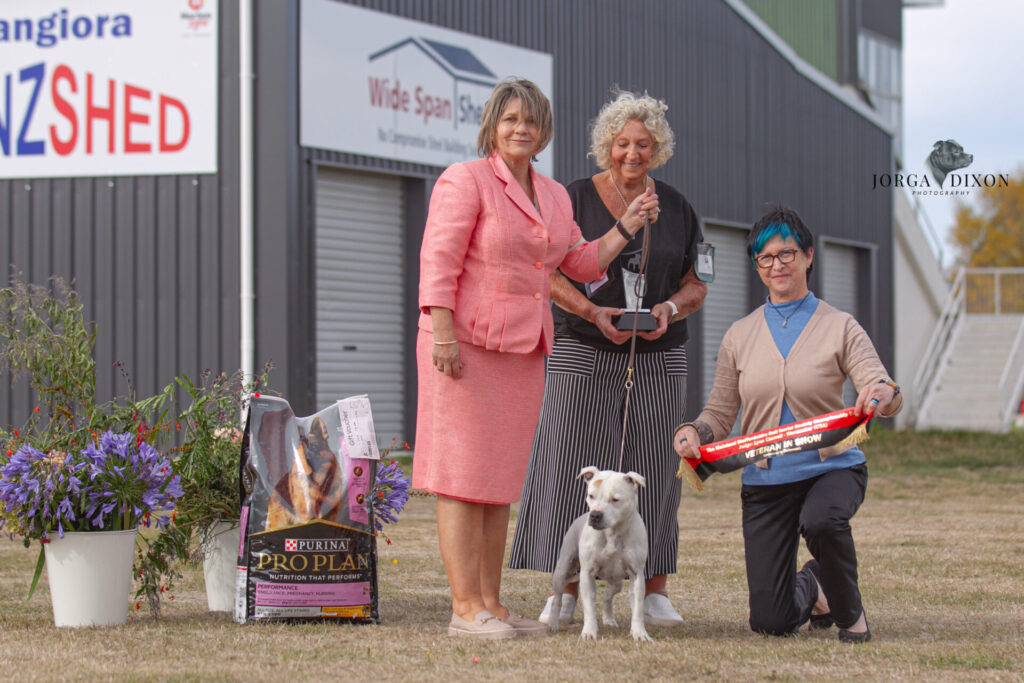
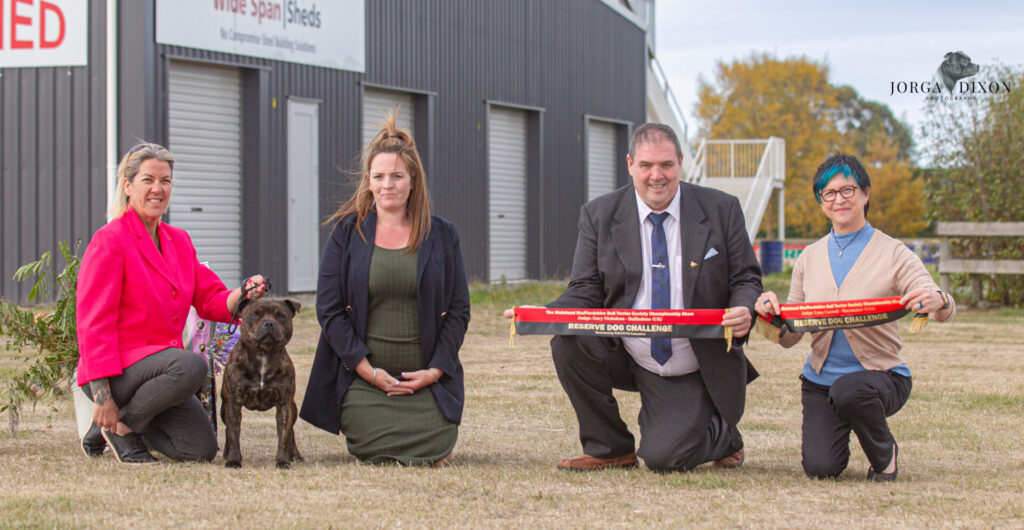
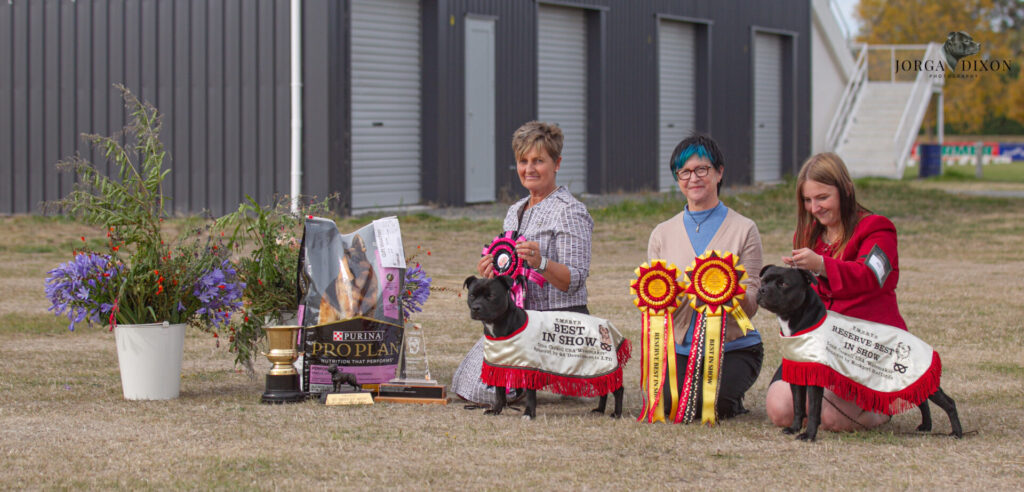
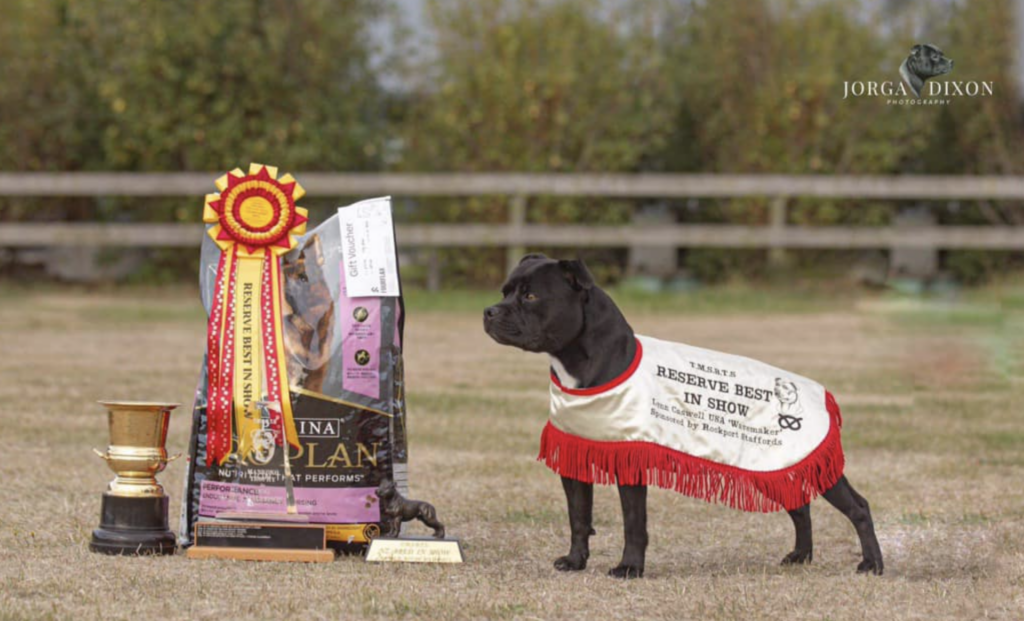
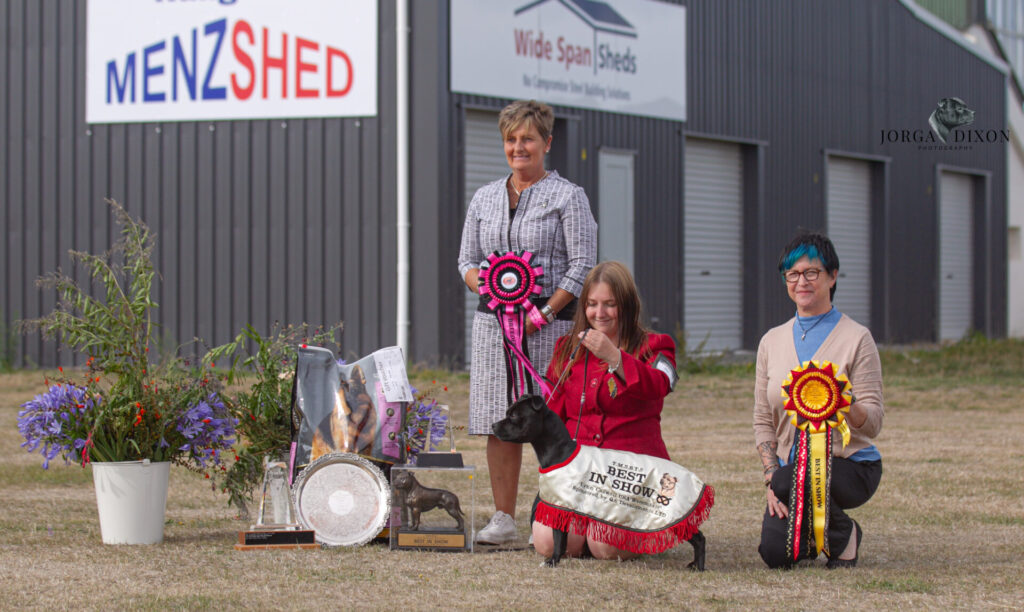
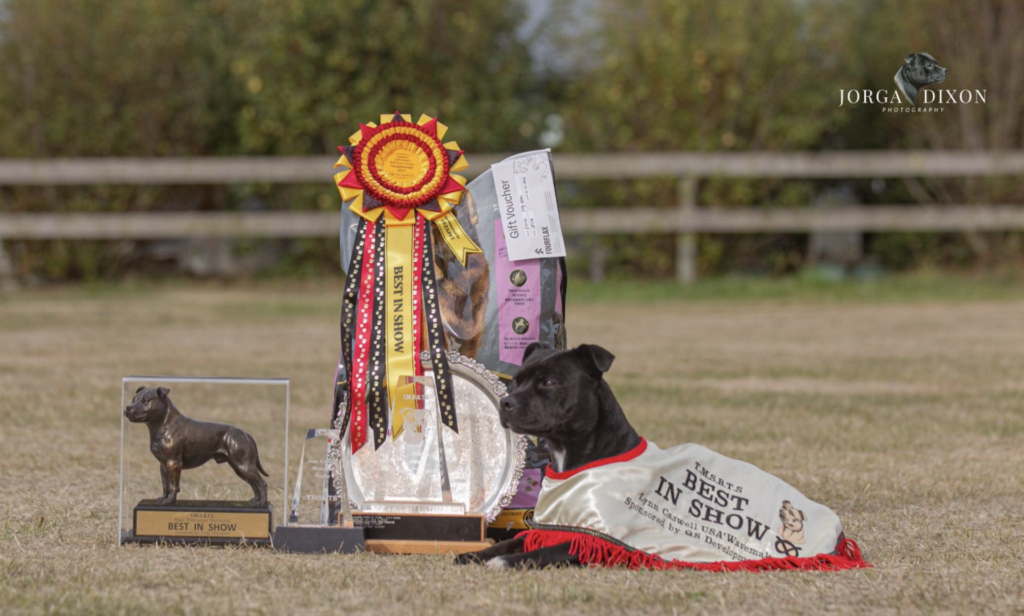
DOGS
Minor Puppy –
1st: #1 L Bartle – Oakamoor Revenge Of Dreams
Red with white on chest, handsome puppy with dark pigment and eyes, well placed rose ears giving him a keen expression, correct muzzle to skull ratio, tight lip and open nares, correct foot turnout, well boned with good length and spring of rib. Once settled he moved with purpose. Best Minor Puppy.
2nd: #2 L Bartle & N Duffield – Oakamoor Divine Revenge
Red with white chest and feet, standard sized compact puppy with very good head, distinct stop, rose ears, nice topline and loads of attitude.
Puppy –
1st: #3 J Croft – Corkscrew Gizmo At Westwood
BB, Standard sized handsome boy with a very good clean head, level topline, correct shoulder layback and lay in, good bend of stifle with low set hocks, this young dog stood four square and is quite balanced.
Junior –
1st:#5 L Evans – Lockmoah Borderline Boss
Brindle with white on chest/neck and toes, Good strong head with darker mask, lots of fill under eyes, good sternum length and drop of chest, good bone, nice ears which he used well. Tail never stopped wagging showing his happy attitude.
Intermediate –
1st: #7 S Vermeer – CH Takoda Game On At Chasewood
BB, strong headed boy, very good width to his front and close coupled in body, nice easy movement, shown in good condition with gleaming coat. Won his class on movement.
2nd: #6 B Waghorn – Redgem Blaze Of Glory
Red, top sized boy with beautiful clean head with no wrinkle, strong cheek muscles and good underjaw. Beautiful strong rear.
Limit –
1st: #8 J Evans-Freeman – Shadowstaff Jakabite Lad
BB with white on neck and chest and rear toes, handsome boy with the darkest of eyes, strong muzzle of correct length, wide open nares, tight lip, front meeting the standard well, close coupled, good bend of stifle and correct low set tail. Best Limit.
2nd: #9 S Smid & J Croft & S Hughes – Blackshot Gone Walkabout (IMP AUST) AI
Brindle with white chest, socks and toes, near perfect muzzle to skull ratio and strong underjaw gives this boy terrific breed type. Shown in good condition, kudos to his owner for putting in the work.
New Zealand Bred –
1st: #12 J Dixon & K Morton – CH Myrah Simply Magic For Renegade
BB with white on chest, This boy stood out to me immediately upon entering the ring. His head meets the written standard well with tight lip, strong masseter muscles, distinct stop, muzzle to skull bang on, excellent fill, wide open nares. Great bone and correct turnout of front feet, excellent layback of shoulder leading to level topline standing and on the move, good rear, clean mover. Another shown with great fitness level! Easily my Best NZ Bred, Challenge Dog, Best Dog and Reserve Best of Breed.
2nd: #11 P Bartlett – Arrowriver Claim Jumper Jack
Red, Top sized with good head with balanced features, dark mask on muzzle, dark pigment around eyes and on ears, correct bite, plenty of bone, deep chest and good length of rib leading to nice light loin, another shown in good condition.
Veteran –
1st: #14 L Bartle – NZ CH Artisinal Ripple Effect (IMP AUST)
Brindle, Clean and balanced head with good length to muzzle, level topline standing and on the move, front and rear assemblies are well balanced leading to good movement overall, everything where it should be.
2nd: #15 S Vermeer – CH Takoda Class Act
BB, Really good length of muzzle on a clean head, well placed neck leading to good shoulders and straight front, clean and balanced all over, easy mover going effortlessly as they should.
3rd: #13 P Day & D Day – CH Challenger Shades Of Black
BB, top sized boy with a bit of frosting on his muzzle on his handsome head which brought a smile to my face, beautiful front, good bone, level topline.
Open –
1st: #16 M Sutton & C Sutton – Smartstaff No Limits
Brindle, top sized with plenty of bone, half prick ears which framed a strong head, excellent masseter muscle, good fill, nice nose leather with open nostril, nice expression, straight front and level topline, good rear. Reserve Challenge Dog
2nd: #18 S Smid & S Hughes – AUST & NZ CH Blackshot EZ On The Eye Warmaster (IMP-AUST)
BB with white chest and toes, beautiful clean head with correct ratio and planes, keen expression made even better with his attentiveness to handler, correct rib length and spring, good bend of stifle, nice level of fitness.
3rd: #17 T Treweek – NZ CH Koendidda Beta Latethan Never (IMP-AUST)
BB and white piebald, top sized strong headed boy with excellent masseter muscles and nice width to muzzle, nice bone, close coupling and calm cool look at me attitude.
—————————————————–
BITCHES
Minor Puppy –
1st: #19 L Evans – Burwell Maia Blazen Tails
Brindle, Everything about this puppy is exactly where she should be for her age, nice head proportions with tight lip and good underjaw, clean and no wrinkle, good straight front, nice tight feet, level topline standing and on the move.
Puppy –
1st: #22 L Pryde – Southstaff Girl On Fire
Red, very clean and feminine head, balanced puppy, front matching rear with, well-conditioned and well presented, Best Puppy.
2nd: #20 T Treweek – Zekiel April Fools Imposter
BB with white collar and socks, flashy girl with a strong head housing correct bite, nice width to her neck leading to correct shoulder layback and good topline. Well angled rear.
3rd: #21 Z Ryder – Corkscrew Peaches
BB, pretty girl who has a lovely outline and calm demeanor, presented in good condition.
Junior –
1st:#24 J Dixon & B Wadsworth – CH Myrah She Can Do Magic
BB, solid girl with good cheek muscles, nice ear placement and carriage, deep chest with longer ribcage leading to nice tuck up and level topline. Worked as a team with her handler.
Best Junior.
Intermediate –
1st: #27 L Pryde & N Nicholson – CH Stafflands Annie Getcha Gun At Southstaff
Brindle with small white patch on chest, good head shape with strong cheek bumps, distinct stop, tight lip, open nares, correct turnout of feet, moved with drive. Best Intermediate.
2nd: #26 M Sutton & C Hoeben – Mankoko Your Pace Or Mine
Brindle, Nice deep tiger brindle coloration, clean head and muzzle, rose ears with good shoulder and rear angles to match.
Limit –
1st: #32 M Abbott – Ashbek Out Of Ink
White, quite a strong headed bitch with gorgeous perfect bite with large canines in perfect position, very dark eye and good ears shape and set, a bit strong in shoulder but excellent overall condition, very good mover. Lovely body on this one.
2nd: #31 N Duffield – Oakamoor Autumn Dream
Red, very pretty girl in fabulous condition, feminine head, great mover, strong rear, good terrier attitude.
3rd: #29 J Johnson – Oakamoor Diamond In The Rough
Red, Good pigment, rose ears framing her pretty face, worked well with her handler
New Zealand Bred –
1st: #33 T Treweek – CH Sladestaff Bring The Noise NCS CGCB CGC B
Brindle with white on chest, Strong headed bitch with good fill beneath eyes, correct rose ears which are well placed, nice wide front showing good bone and correct foot turnout. Beautiful coat color!
Veteran –
1st: #35 L Bartle – CH Oakamoor Mystical Spell
Red and white piebald, this classy veteran won this class on her beautiful effortless movement, she had correct rear drive and wasted no energy which is not surprising considering her structure meets the standard as described. So happy to award her Best Veteran.
2nd: #37 S Carey – CH & NEUT CH Foxestown Bessie Adele
BB with white on chest, I would have taken this lady home in a heartbeat, loved her frosted face, her clean head that is still as balanced as it ever was if I were to guess, pretty front, good shoulders and rear. She pushed very hard to first in this class.
Open –
1st: #40 J Dixon & B Wadsworth – CH Myrah Million Dollar Monster
BB with white on chest and toes, This girl stole my heart with her gorgeous feminine head, smart expression, look at me attitude and beautiful front, well boned for her stature, beautiful outline that says Stafford all day long, level topline, good angles fore and rear, she stood four square yet also spent some time showing her naughty side. She worked well for her handler and moved with purpose, ease and drive. Gave me pleasure to award her Best Open, Best Bitch, Challenge Bitch and Best of Breed.
2nd: #39 B Waghorn – Myrah Monster Mash
Brindle with small white down front and on toes, very correct head with good fill and nice cheek bumps, dark eye and perfectly folded rose ears, nice width to front, level topline and good rear. She pushed hard for first in this class. Reserve Challenge Bitch.
Wanna see some healthy canine sperm?
They say that you can tell the difference in semen quality of correctly balanced raw fed dogs and that of kibble fed dogs. The video here shows one of our collections for Felix. This particular collection contained 604,000,000 sperm with 100% normal, 95% progressive motility.
Normal dog semen ranges in volume from 1 to 30 mL per ejaculate and contains 300 million to 2 billion sperm, of which more than 70% are progressively motile and morphologically normal. Dog semen should contain fewer than 10,000 bacteria per mL.
I post this so you can see it – and if I had a video of a collection from a kibble fed dog I would post to compare.
Why you wait
Warning – this will trigger some!
I receive emails, calls and even some texts weekly from people who are wanting to buy a Stafford puppy who have no idea that good responsible breeders are not Amazon. We are not vending machines waiting for a stranger who probably doesn’t even really know this breed to order up a puppy. We are not in ‘business’. We aren’t running a breeding company. This is not how we pay our bills. This is a passion. We are dedicated to this breed. This has little to do with money or making sure every person gets to buy a puppy.
Stop texting “How much for a puppy” or “Any puppies available?”. Please just stop.
And for those who call and possibly might make amazing homes but you want that puppy yesterday . . . please do the simple math.
A bitch should reach two years old to have all her health testing completed and listed on the OFA website. Hopefully she passes all of these tests and is also a good representative of the breed mostly meeting the breed standard with few faults and no major faults. Thats a lot to ask for. Not all bitch’s will be suitable for breeding.
Next a responsible breeder will have been doing the needed research to locate the right stud for her and also have a back up stud chosen, just in case. This also involves travel to meet the dog in person if possible, studying his pedigree and offspring. Researching his health testing and hopefully performance or conformation records, agreeing to and signing a stud contract, paying the fees.
Then we wait. The bitch has to come into season which only happens about every 7-8 months or so. Next we test progesterone, draw blood daily for LH surge testing (if using frozen) where timing is essential. So now we are about 2 years plus maybe 6-8 months down the road and we wait about 2 more weeks for ovulation to occur. Now we try for a breeding – either naturally, AI or surgically. Each has its challenges and costs involved, plus time and travel.
Now more waiting. In about a month the breeder can opt to ultrasound to see if she conceived. Hopefully all goes well and in another month or so puppies will arrive. More challenges. If there is only 1-2 puppies, a cesarean may be required. Hopefully she can free whelp, its usually around 3am on a holiday when the world is closed. Hopefully no stuck puppies, hopefully no DOA puppies, hopefully no cleft palate or hairlip puppies, hopefully no deformation, and hopefully mama makes it alright too. Next you are awake for two weeks during the ‘please dear lord dont die’ phase. Also hopefully mama doesn’t produce too little milk or too much milk and develops mastitis. Meanwhile if you are counting its been over 3 years. . . . or so it seems.
Most reputable breeders do not let their pups leave until 8-12 weeks. Puppies need this time to learn all sorts of things which are discussed ad nauseum on other pages of this website. So if you call me for a puppy and it just so happens I just bred my girl – you are still going to be waiting around 4-5 months. AND what if you only want a girl and I only have one girl. Welp sorry – I breed to keep a girl. You cant have her. She is mine because of my decades of hard work and wanting that to continue. Sounds harsh but how would I provide more puppies if I sell you my only girl? What if you wanted a puppy for a future performance prospect and none have the temperament for sports? Do you see why you wait?
Find the breeder you want a relationship with and plan to wait. Or dont. Take your chances. Believe the marketing hype. You can certainly find breeders who exist only to populate the world with Stafford puppies. Thats not me. And don’t get me started on those asking me for a puppy and then whinging about how much money I ask for them. Re-read this blog post, and others, and add up the money we spend to create your health and temperament tested well bred puppy. I can assure you, when doing it right we are not making money. Again, this is not a business for us. Leave that to those flashy well marketed and advertised puppy makers with huge egos. I wont call them breeders. What they do is a business. It’s a puppy making business. What we do is not a business.
Also note, its none of our concern who you choose to buy your puppy from. I offer the information all over this website on how to find someone passionate and honest and who truly cares about the breed and the dogs in their care. But it is your responsibility to do your homework and decide for yourself. Do you want lifetime support? Do you want to see proof of health testing? Do you want to meet dogs in person? Do you want a relationship with your breeder and others who also trusted and bought from this breeder? Do you want mentoring about this breed you are about to welcome into your life for (hopefully) the next 16 years? Do you want a friend to support you to be a part of the Stafford community? Do you want someone with experience you can call at any time for any reason to ask questions, brag, share photos, talk with about anything Stafford?
If not, you can Paypal your money and get a puppy shipped to you. Puppy makers will do that for you. Good luck and I hope you don’t need me later to help you re-home your puppy.
End of lecture. If you got triggered look inside yourself to see why.
Wavemaker Makes Waves Again
Wavemaker Staffords is extremely proud to share that 2023 was a history making year for the breed with three Staffords carrying the Wavemaker affix sitting at number one at the same time! This achievement was not a planned goal for us but something we realized late in the year and found out had never been achieved before. We are super excited for Felix, Schooner and Sage and all involved in helping to make this happen. (as of Nov 20, 2023)
MBISS MBOSS GCHG CH Wavemaker Nonesuch TT DN CGCA CGCU TKN VHMA VSWB FITG CHIC
- #1 Stafford (AKC Breed points) for seven months – 2023.
- #4 Stafford (AKC All Breed points) – 2023.
- #1 SBTCA conformation Stafford – 2023.
- SBTCA Top 20 winner – 2023.
- SBTCA Peoples Choice winner – 2023.
- Five Specialty show BOB wins – 2023.
- Four performance titles earned – 2023.
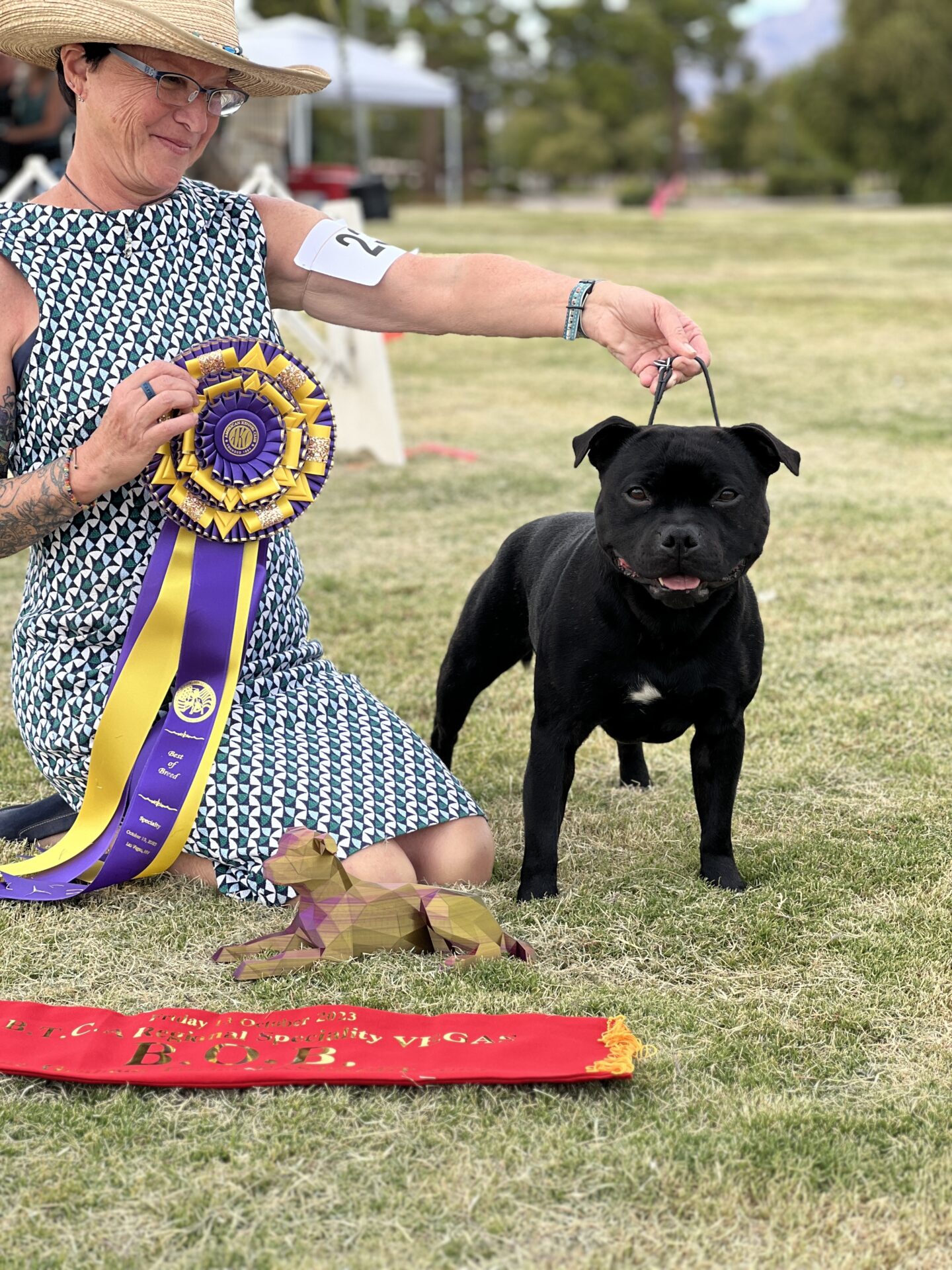
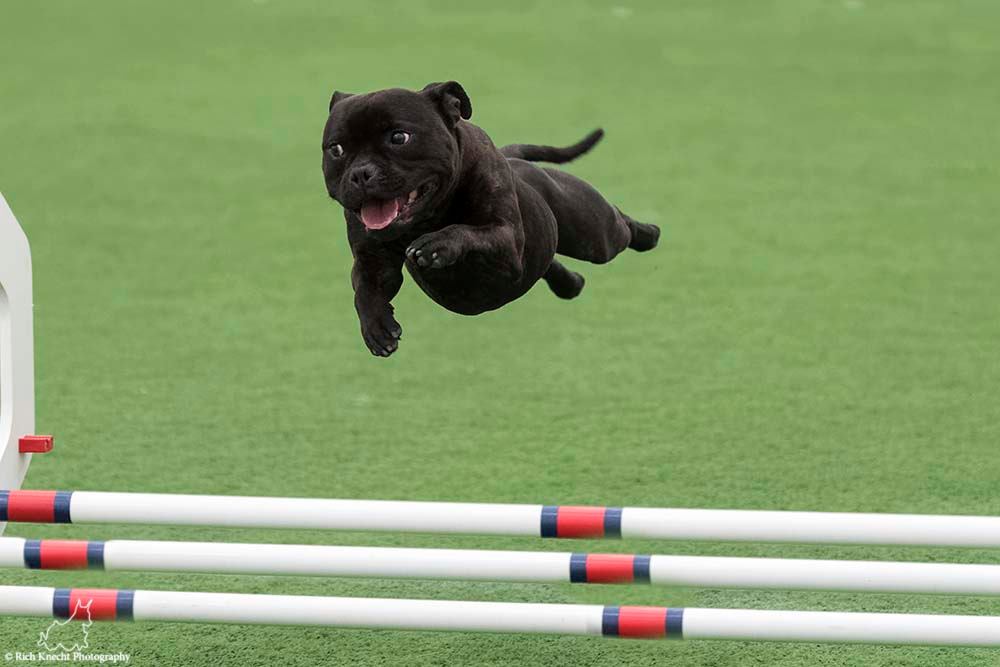
CH MACH4 Wavemaker Atlantica CD RN MXB2 MJG2 XF DS CHIC
- Earned both MACH 3 and 4 – 2023
- #1 AKC Agility Stafford for the Invitational qualifying period – 2023.
- Currently #1 AKC Agility Stafford – 2023.
- #1 SBTCA agility Stafford – 2023.
Wavemaker Surfer Rosa RA FDC NA NAJ CAA FCAT5 MBDCH-G CGC ATT FGDCH
- Two titles earned – 2023
- #1 SBTCA Flyball Stafford – 2023.
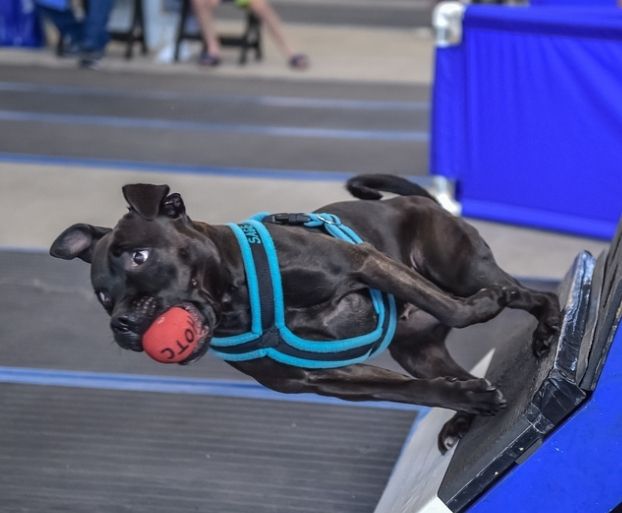
The Tudor Rose
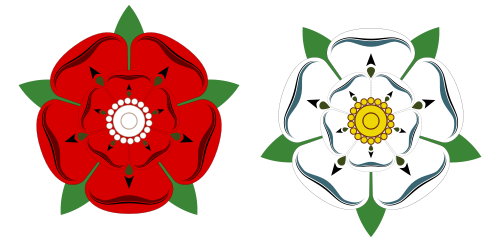
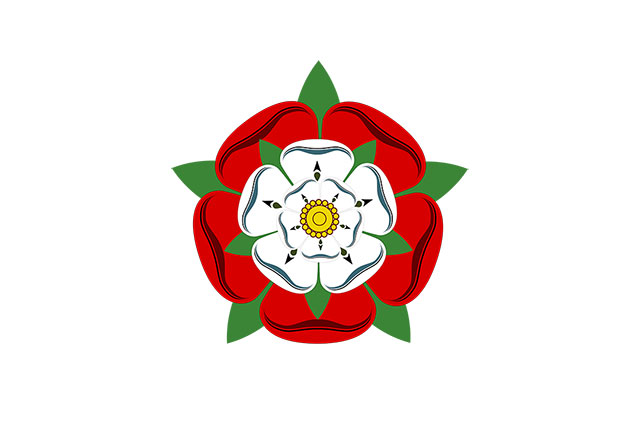
The Tudor rose is, of course, the most poignant symbol, and graphic propaganda as well, of the Tudor dynasty and what it stood for. The visuals are very well-known – the red rose and the white rose together. But what does it actually stand for and what is the significance of it?
A rose with red and white petals is the Tudor dynasty’s heraldic emblem (1485-1603). In the XV-XVI centuries symbols and emblems were very popular. Every English nobleman used one or few images as some kind of identification mark. Heraldic emblems used to adorn almost everything, ranging from nobleman’s personal banner to his housewares. Every wedded pair had his personal sign combining marrieds’ symbols. That’s exactly the way the Tudor rose appeared. In 1486 the founder of the House of Tudor, Henry VII, married king Eduard IV’s daughter (1461-1470; 1471-1483). Tudors traced their genealogy to the House of Lancaster. The latter had a red rose as his symbol. Eduard IV’s favorite emblem was also a rose, but a white one. Red-and-white rose signified a union between Henry VII and Elisabeth of York.
It has been suggested that the red rose “probably owes its popular usage to Henry VII quickly responding to the pre-existing Yorkist white rose in an age when signs and symbols could speak louder than words”. What this means is that it was believed the red rose was never really the symbol of the Lancastrian cause, but that Henry VII made it so because he wanted a symbol that represented the union of the houses. Personally, I do not believe this. I think that the red rose was the defining symbol of the House of Lancaster in order to contrast with the white rose of York. The red rose is now the symbol of Lancashire as a whole. The colour red implies danger, blood and battle. There certainly were battles, as Henry V won at Agincourt, and Henry VI lost his throne at the Battle of Towton.
The white rose is a different story. It was used to contrast with the red rose of the House of Lancaster in order to clearly define the two sides. It was definitely in use during the fifteenth century, even if the red rose was not. The white rose has since been adopted as the symbol for the whole of Yorkshire.
When Richard III was killed at the Battle of Bosworth Field, Henry Tudor took the throne as Henry VII. He was the Lancastrian heir at the time, and he married Elizabeth of York, daughter of Edward IV and Elizabeth Woodville. This ended the Wars of the Roses by uniting the two houses, and the two symbols were merged to create the iconic emblem of the House of Tudor.
The Red Rose of Lancaster and the White Rose of York, are combined to create the iconic Tudor Rose.
The combination of the red and white represents unity and mutual regard. It was supposed to demonstrate that England was united and that civil war was over. The Tudor rose was carved onto buildings and liveries in order to demonstrate their loyalty to the crown.
It is worth studying the history of the Tudor rose at least to understand that there are so much politics and so surprisingly little truth about it. Firstly, the White and the Red Roses were not the common symbols of the House of Yorks and the House of Lancaster, they were used just from time to time along with the others. Secondly, the idea underlying the Wars of the Roses is very far from being true. At that time people were not thinking about the period from 1450 to 1480th as of the confrontation between two Roses. Probably they did not even know that they were living during the period of a civil war. Plenty of frightening details were just invented by the court propagandists in order to support the reputation of the new dynasty. In the course of time, the legend of the War of the Roses has accumulated more and more details. Shakespeare has created the scene in which the House of Yorks has chosen the White rose as their symbol, while the Red was chosen by the House of Lancaster and both have sworn to hold these flowers ’till the death. The expression “War of the Roses” has appeared much later – in the 19th century. And it’s interesting to know that it has been spread not by a historian but by a writer – famous Walter Schott.
I am designing, with another artist, the graphics package for the SBTCA 50th Anniversary Jubilee Weekend celebration – We have chosen this iconic symbol to represent the much needed ‘coming together’ required in order to make possible what a clubs purpose is: “To Promote, Preserve, Protect” the Staffordshire Bull terrier in unison, as a strong group of enthusiasts who must work together to achieve this goal and to respect our history and traditions of the Stafford.
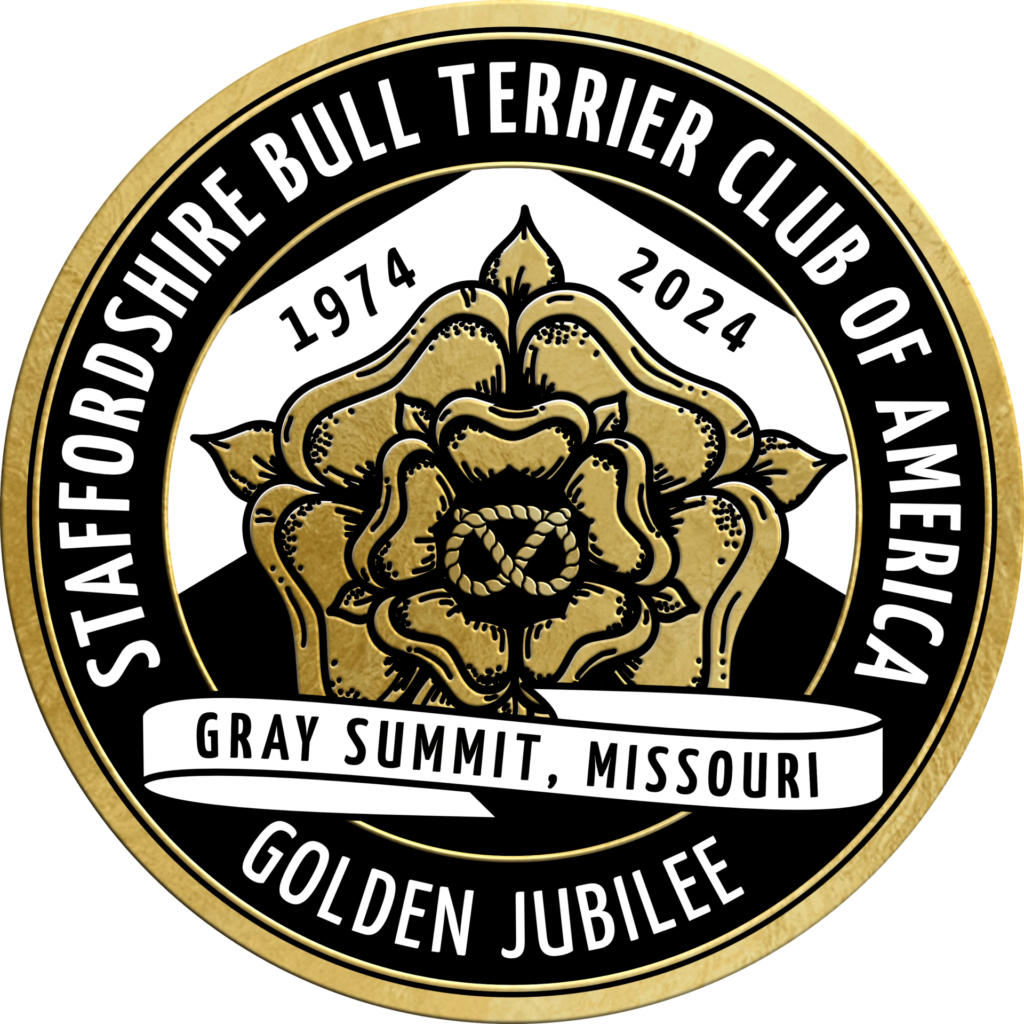
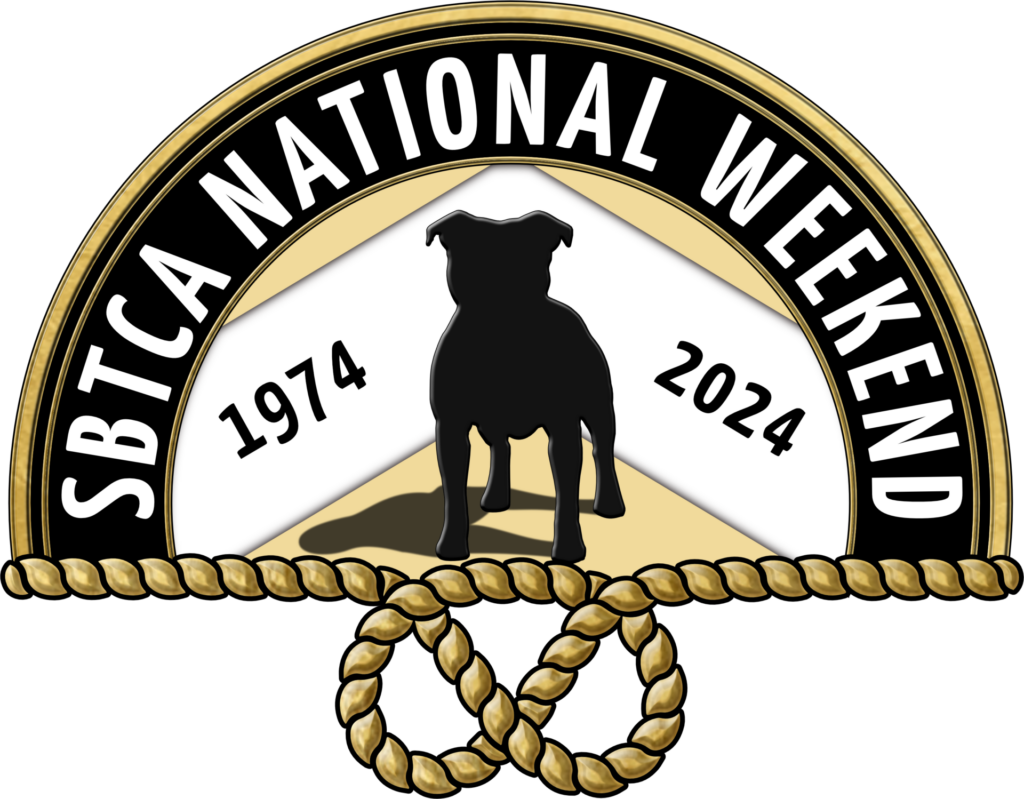
Faults and Serious Faults in the Stafford
In the country of origin, UK, at the end of the written Breed Standard for the Staffordshire Bull Terrier it is stated:
“Any departure from the foregoing points should be considered a fault and the seriousness with which the fault should be regarded should be in exact proportion to its degree and its effect upon the health and welfare of the dog and on the dog’s ability to perform its traditional work.”
This is a good reminder to not only look for the balanced Stafford, remember its origin, but also to balance your judging when in the ring with the breed. The AKC Breed Standard for the Stafford lists only three ‘faults’ and only three ‘serious faults’. Fault judging is to be avoided but these six points should be kept in mind when you find yourself faced with similar virtuous examples in your ring from which to select from. The standard was written as a way to describe this particular breed as a blueprint to follow to differentiate the Stafford from other terriers.
Faults:
- “Non-conformity with heights to weights limits” – Our Standard calls for dogs 28-38lbs, bitches 24-34lbs with both dogs and bitches being 14” – 16” at withers. They should be balanced height to weight. BALANCE is the key word here. Get familiar with what 34lb bitches and 38lb dogs look and feel like. And remember a 14” dog is in Standard and is balanced at 28lbs just as a 16” bitch is in Standard and balanced at 34lbs.
- “Dark eye preferred but may bear some relation to coat color. Light eyes or pink eye rims to be considered a fault, except that where the coat surrounding the eye is white the eye rim may be pink.” This means we prefer a dark eye but in a red or brindle dog, for example, there can be some consideration for a lighter brown eye. We do not want to see yellow, gray or blue eyes at all no matter what coat color.
- “A tail that is too long or badly curled is a fault.” This is self explanatory but to be taken into consideration as to the above paragraph regarding degree and affect upon health. Also, in the original point system the tail was valued at only 5 points. I’ve heard it said that if the Stafford has one thats half the points right there.
Serious faults:
- “Pink (Dudley) nose to be considered a serious fault.” The Stafford nose needs to be black. Some argument of consideration could be made for the blue Stafford but even then we want the darkest possible pigmentation so that the nose appears black.
- “Full drop or full prick to be considered a serious fault.” A small, thin leathered tight ear held back close to the head would be preferred and safest in its original function, however there is consideration for a half prick ear. This means half, not 3/4 and never full drop or full prick. Either of those not only would affect hazzard in its original fuunction, but also gives a foreign expression. As well this differentiates the breed from other terriers.
- “The badly undershot or overshot bite is a serious fault.” The scissor bite is called for, and we want large well placed canines but as we also strive for a strong muzzle and underjaw, a slight under/over may not affect the original function – however – converging canines would affect the health and comfort of the Stafford.
Again, it is worth repeating – please keep in mind the exact proportion to its degree and its effect upon the health and welfare of the dog and on the dog’s ability to perform its traditional work when judging this breed. With only these few faults mentioned they should be easy to keep in mind.
Is it flattery?
The phrase "Imitation is the sincerest form of flattery" originated from Oscar Wilde's famous quote, "Imitation is the sincerest form of flattery that mediocrity can pay to greatness." The phrase has been used by many authors as early as the 18th century, but Colton's variation is the one English speakers still use today. While flattery can influence a person's opinion, it is not always flattering. In the world of commerce and intellectual property, such "flattery" can get you in serious trouble.
Oftentimes when a sincere person has the time and energy to put forth creative efforts, over time others may imitate those efforts. For over twenty years I have devoted my time, creativity and energy into all sorts of promotion and support for the Staffordshire Bull Terrier. If you are familiar with this blog, then you also have read this website and you know all the projects I have involved myself with for this breed. Let me highlight just a tiny percentage of what I have accomplished for this wonderful breed below.
From my earliest days I did not wait for others but instead I created ways to raise awareness for Breed Specific Legislation, raised money selling anti-BSL bracelets and fought to change laws, attended hearings, written letters, made calls and helped those caught in the middle of such bad legislation.
I created forums and websites with educational material about Staffords.
I promoted health testing in the breed, including being involved with SBTCA getting blood draws needed to locate markers for L2-HGA and HC and shipped to UK.
I published books and magazines about the breed.
I ran Responsible Dog Ownership events. I taught inner city dog owners how to live in big cities responsibly with their dogs. I taught handling lessons on my property and other locations.
I was immediately involved with Stafford rescue not just raising money but actively pulling from shelters, visiting hoarder situations to pull dogs, fostering and transporting, as well as vetting new homes. Many claim to be ‘involved with rescue’ when they only raise money or talk about it but never get their hands dirty. This is also needed but don’t inflate your involvement while putting down others who get in there and do the hard parts.
I have served on just about every club committee, have created a committee (Sunshine),
I started SBT Mentor. Sadly, after ten years I closed it down due to lack of interest. I was having trouble finding people willing to mentor and new people to this breed didn’t think they needed mentors. Thanks in part to social media, they knew it all already.
I have helped rewrite our COE and By-Laws to clarify them and I served on the BOD.
I helped create and edit an Illustrated Breed Standard and a Seminar and donated all the proceeds to rescue. My work is the base for the parent clubs book and seminar. I created The Stafford Knot, Inc 501(c)(3) and I run 3 online stores all with Stafford gear with proceeds donated to rescue I have imitators who mimic my work and put the money in their own pockets who could help by making small donations but instead put our work down in order to promote their own. My designs have been stolen and used worldwide!
I did all of the graphics, marketing, design, social media advertising, fund raising, trophy making (actually physically making them), did promotions, got sponsors, and I did much of the organization for one of the breeds largest National Specialties. You may not be aware that was me since another person takes credit for my hard work when at the time they were grateful and even said – “You could have done this show without me, but I could never have done it without you..”
I have traveled to get my hands on as many Staffords as possible while learning and studying because you never can learn too much about a breed. I photographed, listened, watched and learned from those with many more years experience than myself. Without them I would be lost because today people are not as open and willing to share knowledge. (That is one reason for this website and The Stafford Knot website).
All of this and then some just because I value, appreciate and honor this breed and its traditions and history. I didn’t do any of this for myself or to get a pat on the back. IDGAF whether or not you approve of what I have done and I certainly don’t need your approval to continue. So many others are desperate for that approval and praise. I did, and continue to do all of this for the breed.
I do not brag about my accomplishments or efforts, except perhaps in this blog. Not that it’s shameful to let others know what you do . . . if you are actually putting in the work. This, by the way, also includes talking about your failures and shortcomings and how you learn lessons with grace and dignity. It also includes being open to being wrong and listening to those who are also learning and doing. You don’t, however, get to opening publicly disparage others.
Peoples actions really do speak louder than their words. Actions, especially patterns of actions, show intent. A persons intent says everything. If you pay close attention you begin to stop listening to words and begin to find imitators actions amusing. If a persons intent is not pure, then they will fail at their actions. No matter what their words say, their intent will show through – if you are looking. Most people are not looking, only listening. If you truly are a legend, you don’t need to tell people you are a legend. And I am certainly NOT saying I am – but others who loudly boastfully claim to be just might not be if you watch them and stop listening to them. If they are either disparaging others, copying others or taking credit for others work then perhaps you may begin to wonder what the truth really is.
Is it flattery? I don’t feel that it is. I feel they may see others succeed and be well respected so they mimic in hopes to gain the same for themselves. But since it is not sincere then it fails. Start paying attention. Oscar Wilde was correct.
Looking for a Stafford?
Questions you should ask potential breeders.
When going to select your Staffordshire Bull Terrier puppy, there are several very important questions to ask the breeder. These will help you determine if you have found a good and reputable person whom you are comfortable with. After discussing the following points with the seller, ask yourself, “Is this the right breeder for me?”
Regarding the Puppy’s Background:
Specifically, what health testing has been done on the parents and what are the results? (health testing should include Hips (either OFA or PennHip), OFA Elbows, OFA Patellas, OFA Thyroid, CERF, OFA Cardiac), DNA L2-HGA, DNA Hereditary Cataracts or proof of parents testing clear.
In this puppy’s pedigree, what is the incidence of hip dysplasia, heart defects, elbow/shoulder dysplasia, demodectic mange, thyroid dysfunction, seizures and allergies? (Genetic defects such as heart conditions, and diseases related to immune system dysfunction such as allergies or demodectic mange, are surfacing in alarming numbers. These problems are more evident now that more reputable breeders are openly discussing them and sharing their experiences in the hopes of reducing the occurrence of these defects. Seriously question the breeder about the appearance of any of these issues in the puppy’s ancestry.)
Are there any temperament problems in this puppy’s ancestry?
Have the sire and dam been temperament tested?
Do you offer Health/Temperament guarantees with your puppies?
Can you show me certificates proving that the sire and dam are OFA certified or PennHip evaluated? (this is important because it tells a lot about the dedication of the breeder to eliminate genetic problems in the breed), this info can also be verified for free at www.offa.org.
Will you provide me with the pedigree (at least 3 generations, and should be AKC or KC or reputable registry, not UKC), the puppy’s health record, and instructions on how to care for my new dog?
Regarding the Breeder:
How knowledgeable about Staffordshire Bull Terriers are you, and will you share that knowledge with me? (The breeder should be willing and able to answer most of your questions regarding medical care, feeding, diseases, training, what to expect as the puppy grows up, etc. If you have a question that the breeder cannot answer, he or she should have a network of sources available to get the answer for you.)
Does the breeder have more than one breed of breeding dogs?
Will you make yourself available to answer any concerns I may have at any time during the dog’s entire life?
Will you assist me if I cannot keep the dog? (Even with all the careful screening and education that breeders do, occasionally something happens where a purchaser must give up the dog. In the unlikely event that this should happen to you, the breeder should be willing to help place your dog in a suitable new home.)
What are the most important things you strive for in your breeding program? (this should be something to the effect of making the breed better) How much time do you spend planning litters and rearing the pups?
Do you require a spay/neuter agreement on the puppies you sell? (This is a good requirement and you want the breeder to say “yes” unless you are an experienced breeder and you BOTH agree the Stafford shouldnt be intact) Will you ask me a lot of questions during an “interview” process? (All reputable breeders will have lots and lots of questions to ask you. This helps them determine if you are suited to Staffordshire Bull Terriers in general, and to their line of dogs specifically. They need to be certain that you have what it takes to care for one of their dogs for the next dozen or more years. Don’t be offended by these questions. Be happy that the breeder is doing all that he or she can to find a perfect match between dog and your family.)
Is your breeder experienced?
HOW DO YOU KNOW IF YOU ARE DEALING WITH AN EXPERIENCED, KNOWLEDGEABLE, AND REPUTABLE BREEDER? This question can best be answered by considering the conversation that takes place when you meet him or her. A good breeder will want to know things about you, will tell you things about himself, and will tell you things about the dogs in his or her kennel. Here is a guide to help you determine if you are dealing with a good breeder of the Staffordshire Bull Terrier. Regarding You, the Breeder Should Ask Questions Such As:
Who are the members of your household? What is your lifestyle?
What kind of home do you live in?
Do you have a fenced in yard?
What do you know about Staffordshire Bull Terrier?
Regarding Him or Herself, the Breeder Should:
Belong to, and be active in the National and Regional Staffordshire Bull Terrier breed clubs.
Show his/her dogs in conformation and/or agility, nosework, dock diving, barn hunt, obedience or other performance sports.
Actively help with rescue and/or public education for the Staffordshire Bull Terrier.
Require a spay/neuter contract with each sold puppy unless you are an experienced breeder and you BOTH agree the Stafford is a good specimen for producing.
Offer a contract which guarantees health and freedom from genetic defects. Discuss the advantages and disadvantages of owning an Staffordshire Bull Terrie. Discuss general health matters and breed defects found in Staffordshire Bull Terriers. Require you to return the dog if you cannot keep it for some unforeseen reason. Be available to help you at anytime during the dog’s entire life.
Regarding the Dogs in the Breeder’s Kennel, You Should:
Be invited to the breeder’s home to see the dogs if possible or at the very least offer a FaceTime ‘visit’ or meet at a show.
See happy, friendly, outgoing, tail wagging puppies.
Find a clean, safely fenced in, warm, nurturing area for the dogs.
Be referred to previous purchasers to ask them about their satisfaction.
REMEMBER-A GOOD BREEDER IS WORTH FINDING !!!
adapted from alaskanmalamute.org
SBTCA National weekend
We are still on the road after the 2023 SBTCA National Specialty weekend in OKC but I wanted to make a quick blog post about Felix and his recognitions. I am being told there is some story twisting happening on FB which I am not on. Always a few in every hobby/sport who feel in order to be noticed they must put down others. Its a sad way to live but maybe that works for them.
Felix was the number one Staffordshire Bull Terrier in breed points from January 1, 2023 through May 28, 2023 and then again beginning in July. He also has made the cut and/or been in the ribbons at every Specialty he has been entered in. He was awarded SBTCA Top 20 Stafford and also Peoples Choice winner this year. Felix is our 5th Stafford to be Crufts Qualified and several of ours have qualified multiple times – and Marina showed at Crufts. These are not ‘fake’ or ‘made up’ achievements, nor do these negate the achievements of others. These are simply facts.
We love going to the large shows and seeing the beautiful Staffords from all over this country and those who bring dogs over from other countries. Its usually a welcoming atmosphere even though there is some drama sometimes, usually the drama is caused by the same few people so its easy to spot and avoid. We want nothing to do with that side of showing dogs.
We are thrilled that we were present to see so many wonderful Staffords get recognized this past weekend. Congratulations to Mary and Vivian who now are number one Stafford in breed points. There also were many more who went without awards who were just as deserving. Safe travels home to all and we look forward to seeing you at the next Specialty shows.
